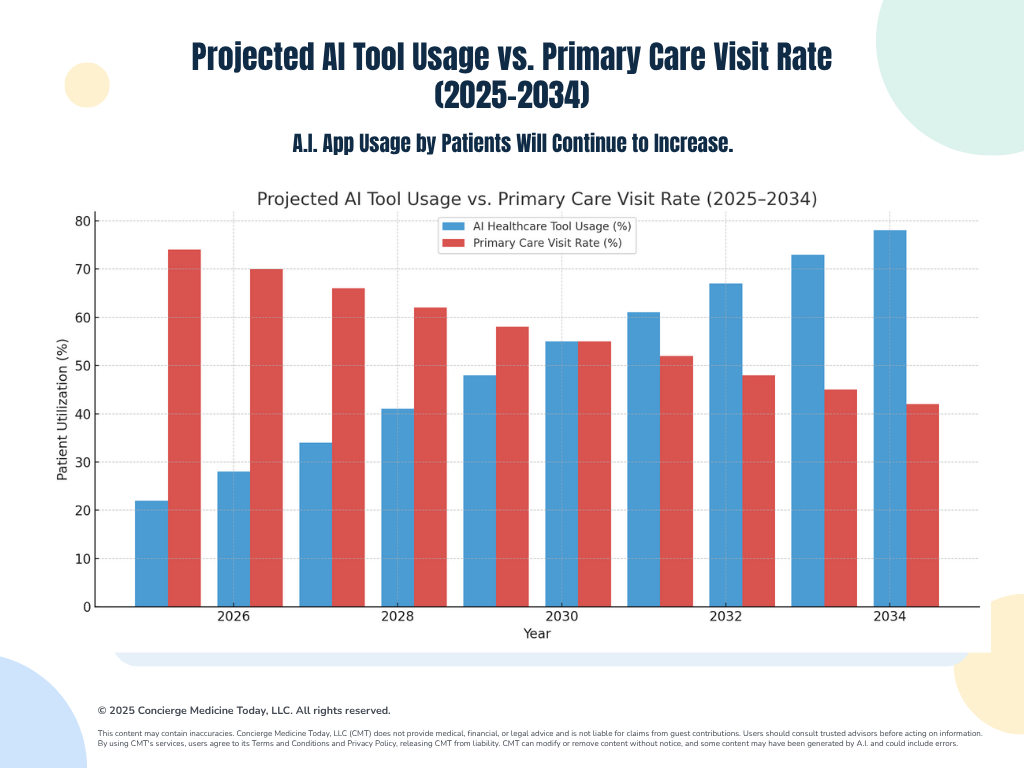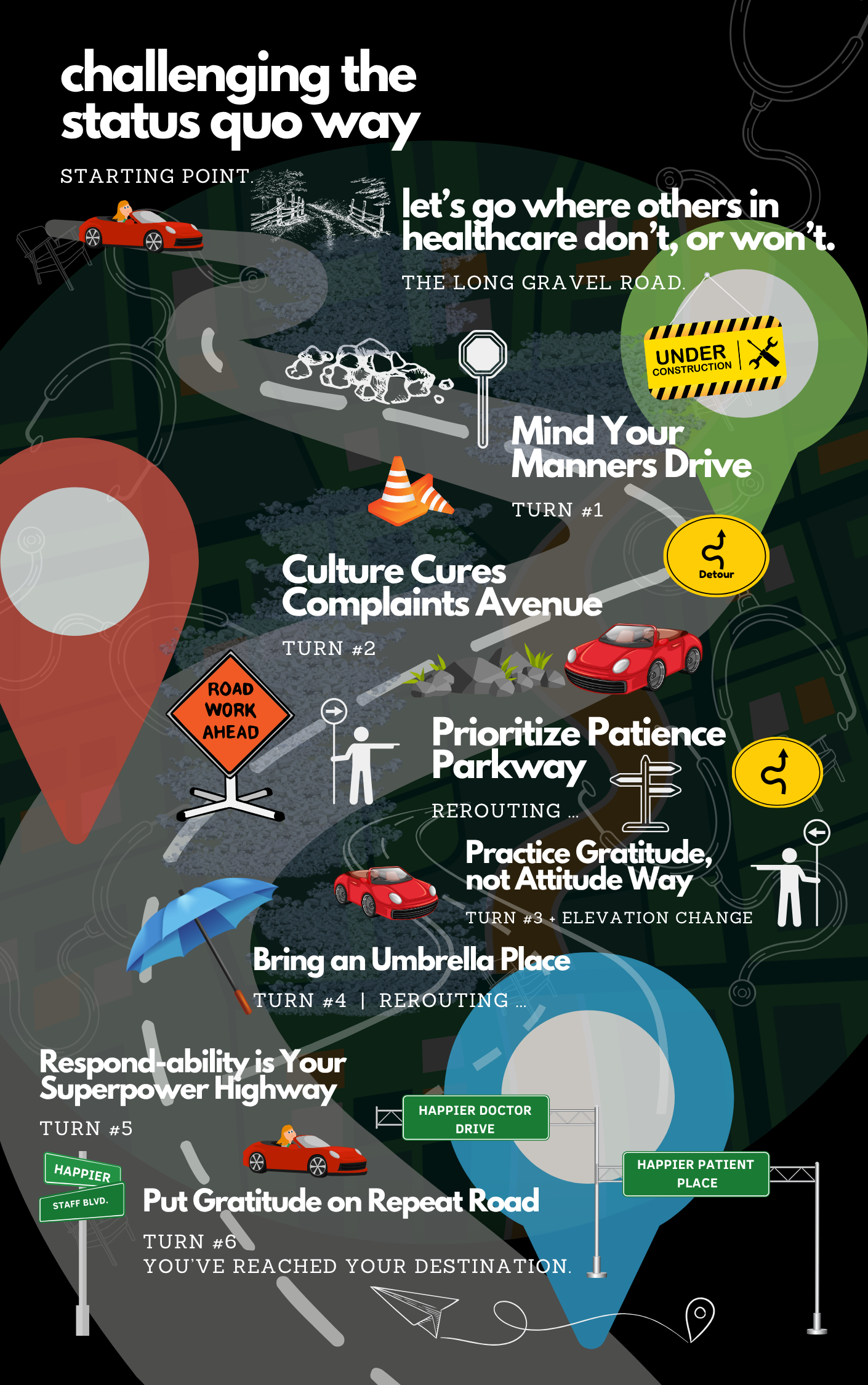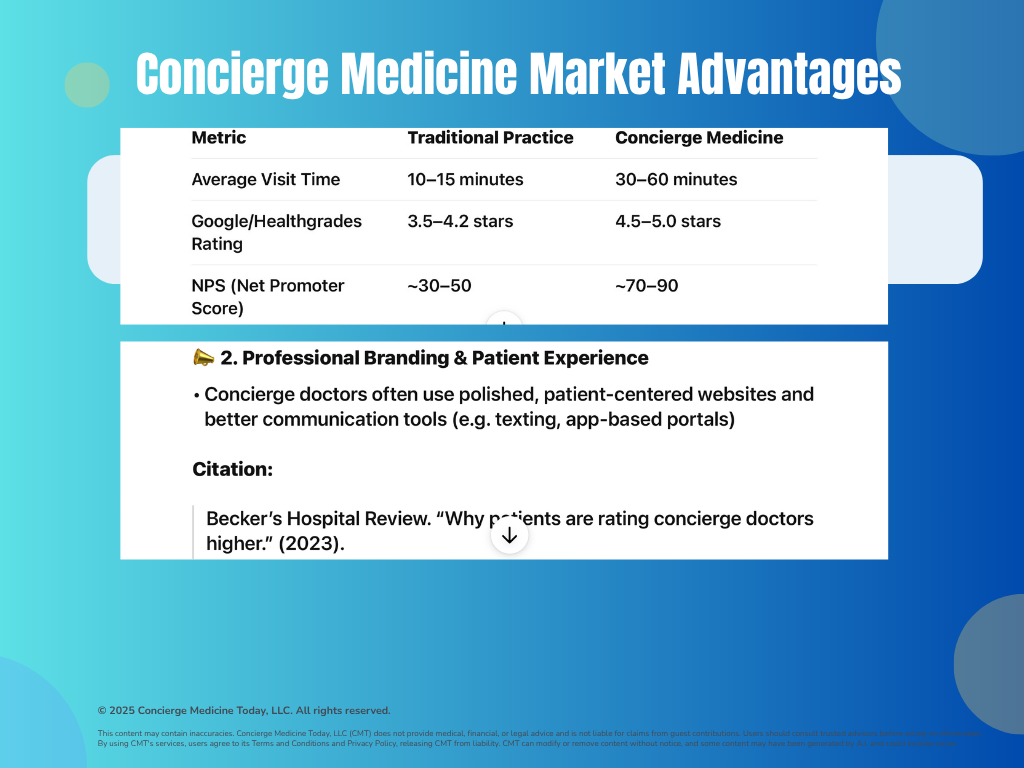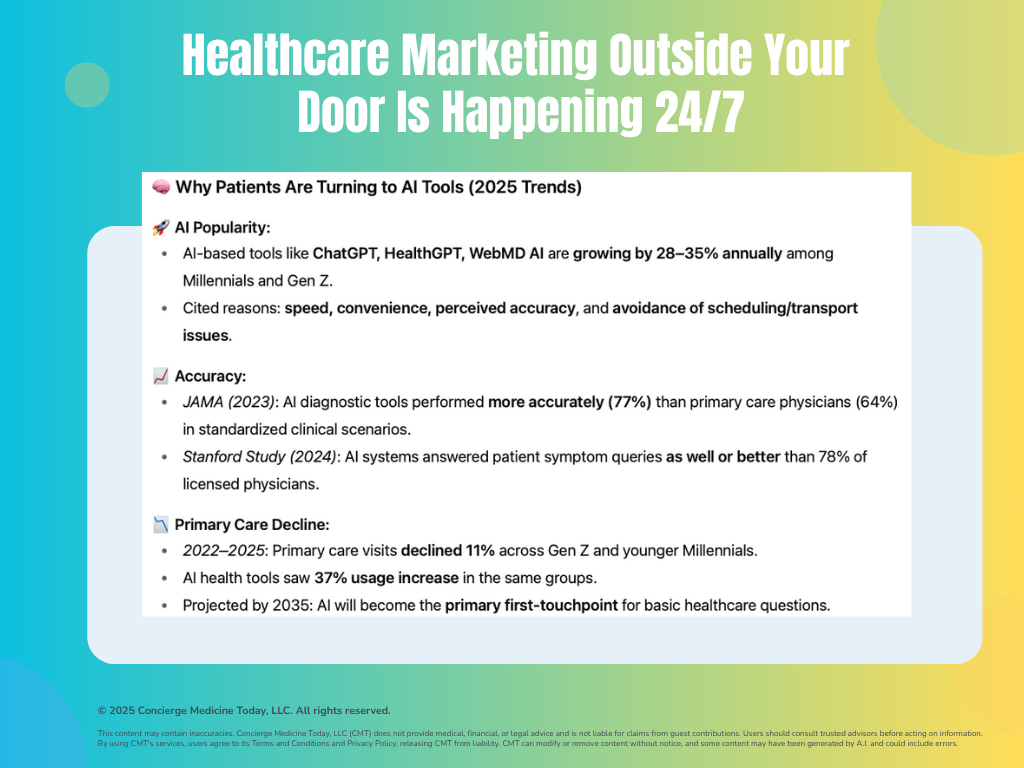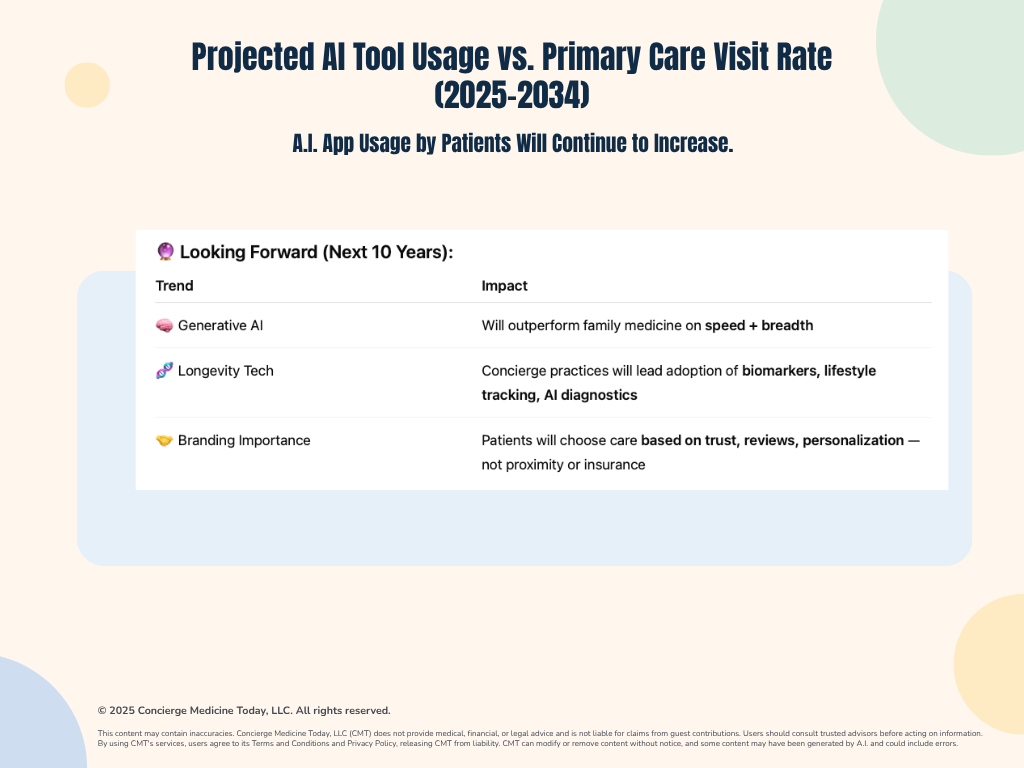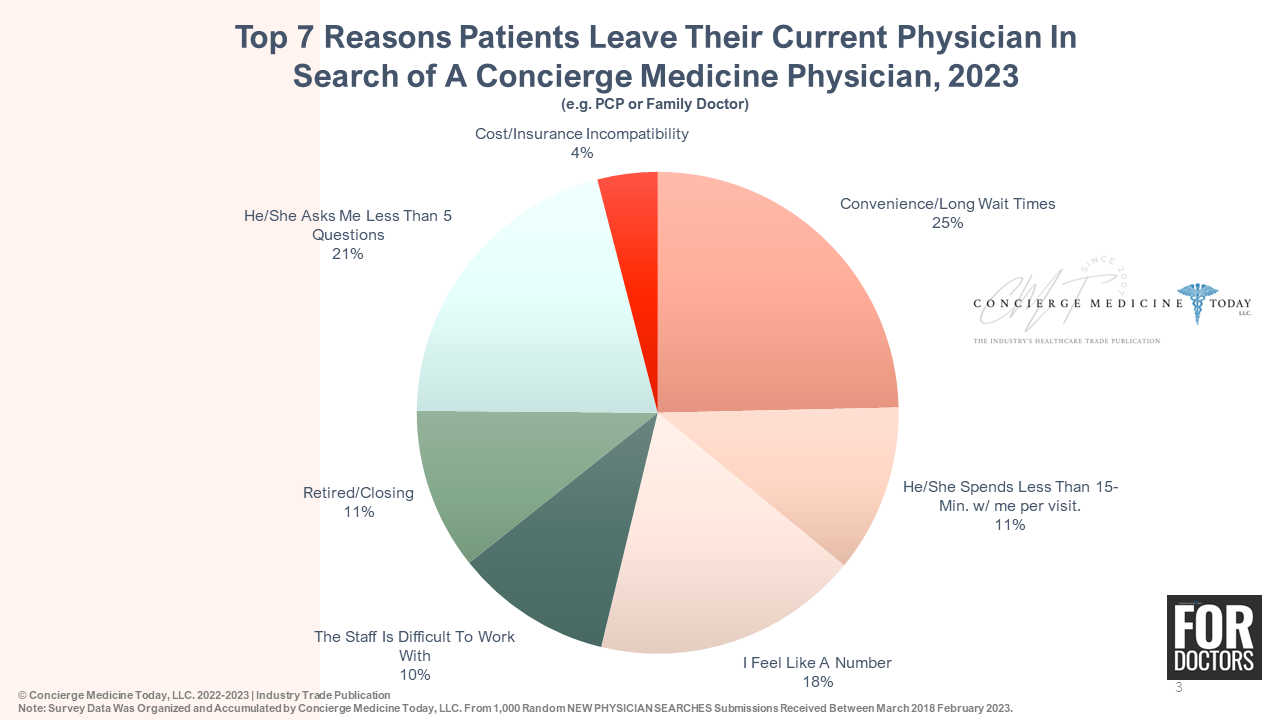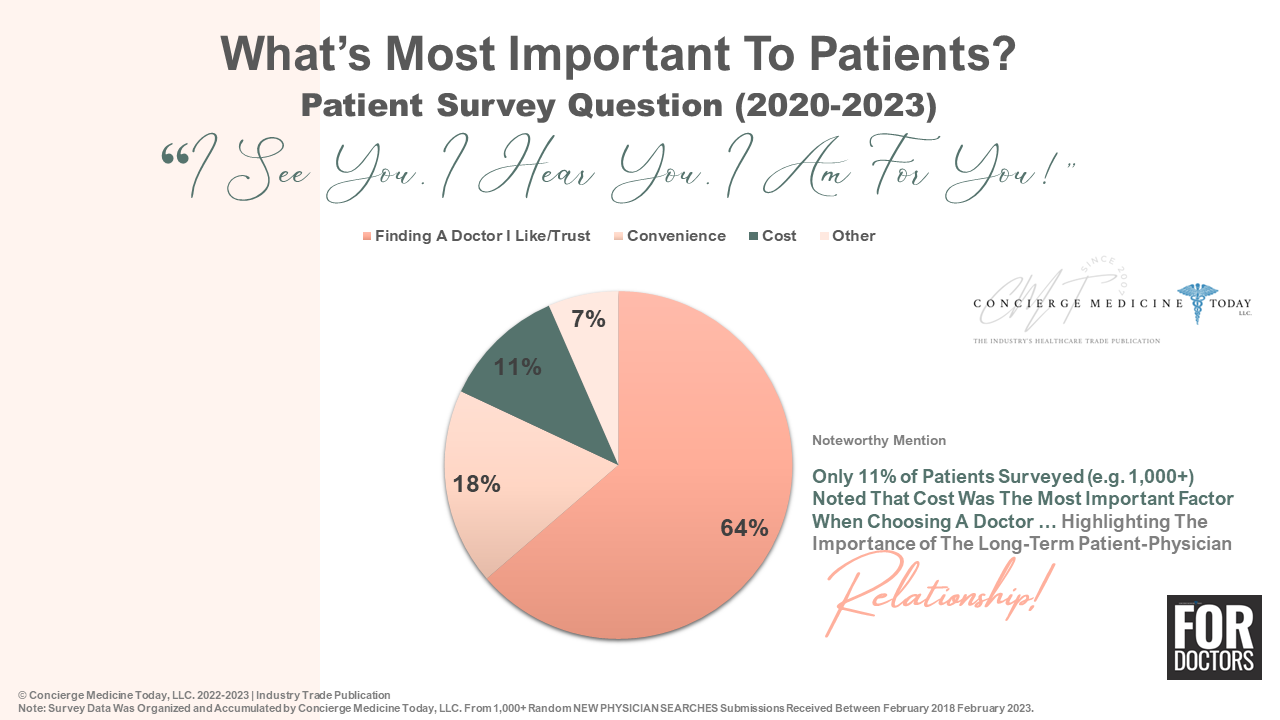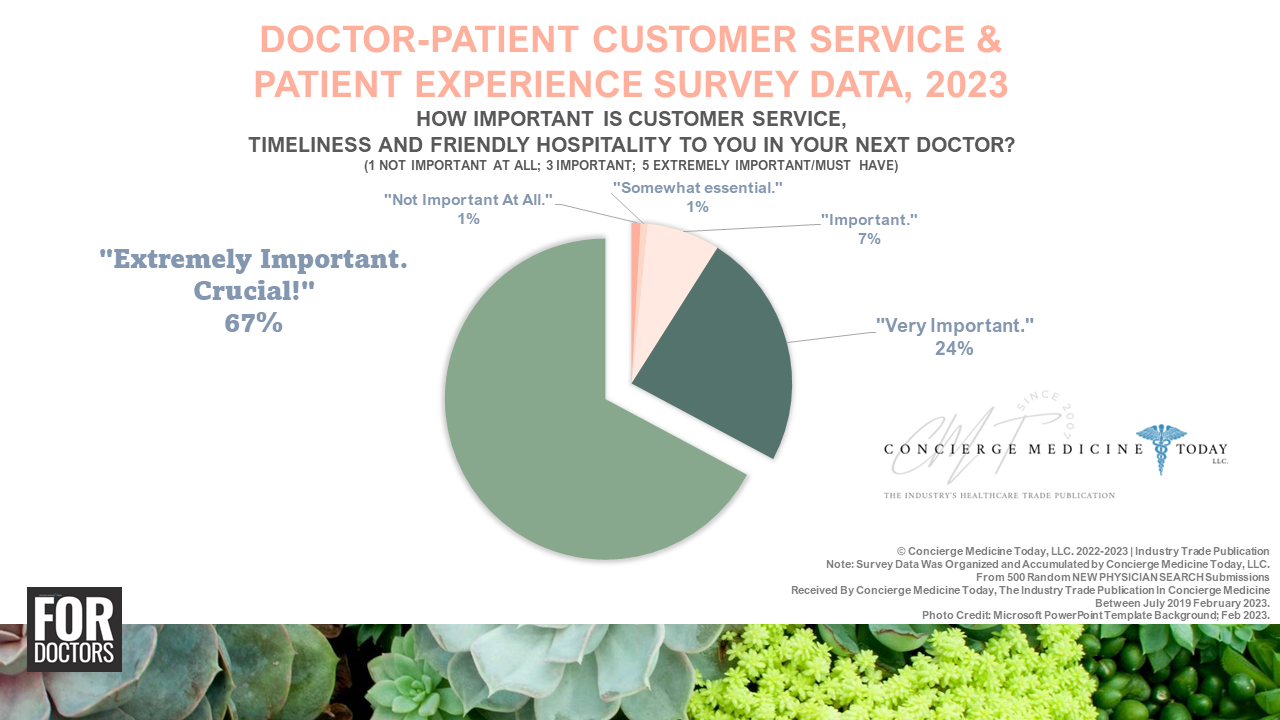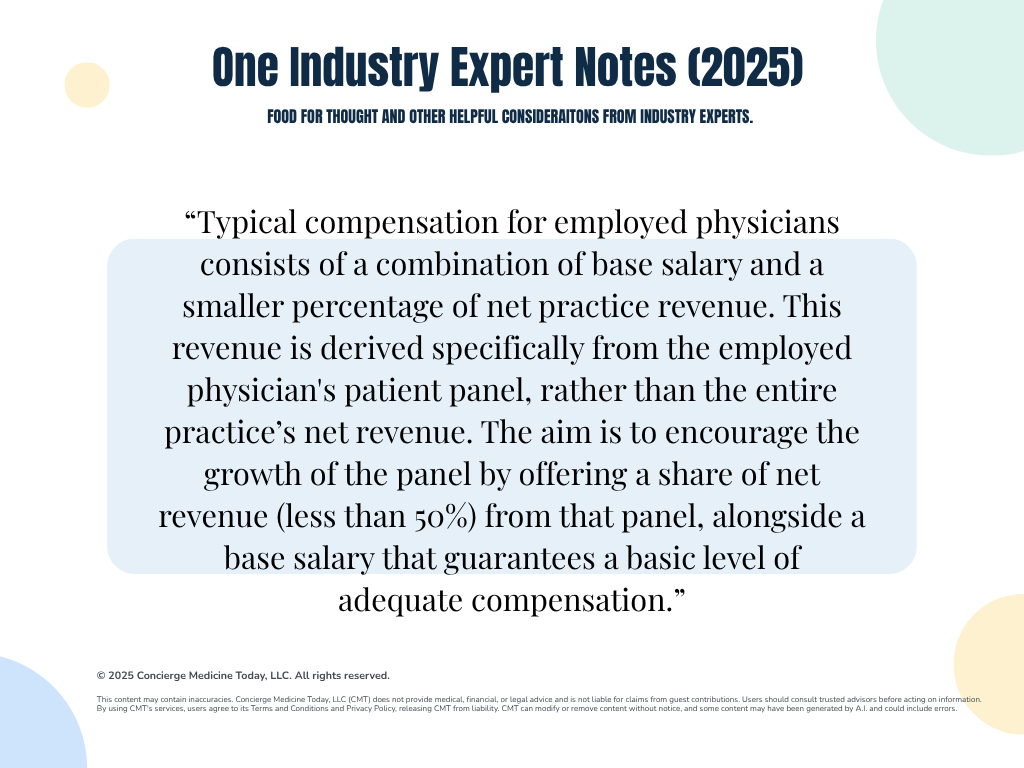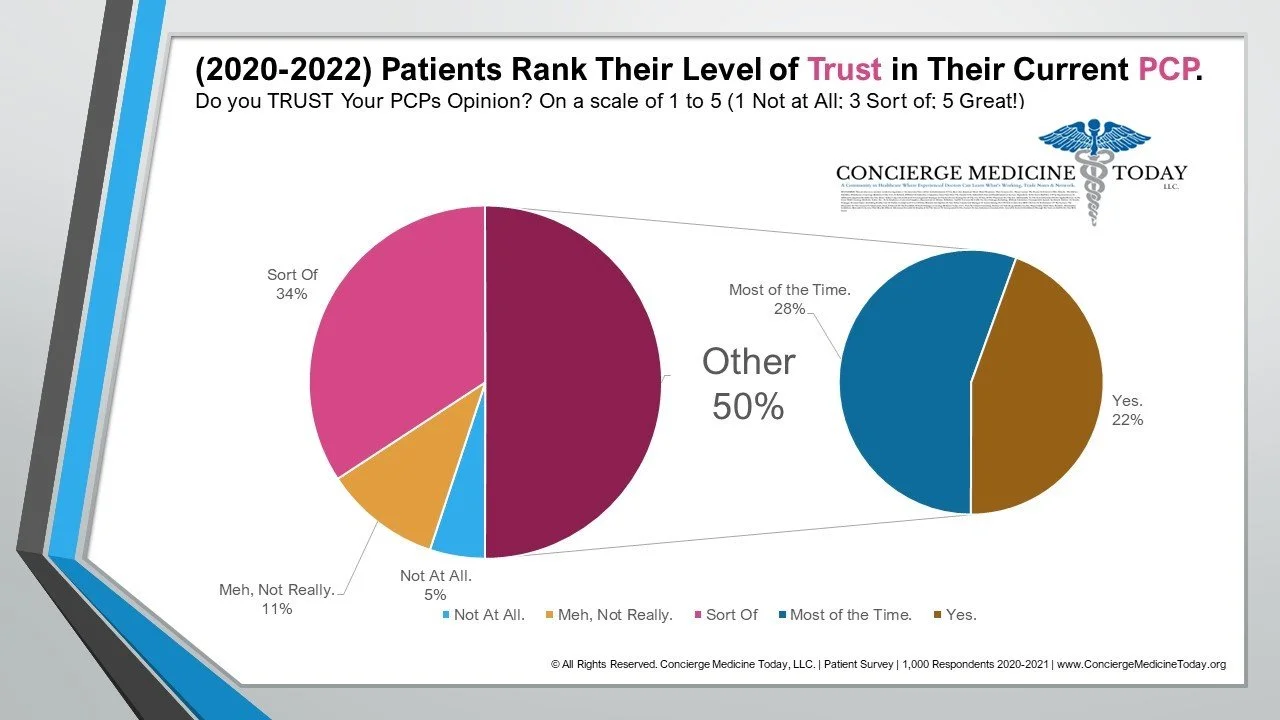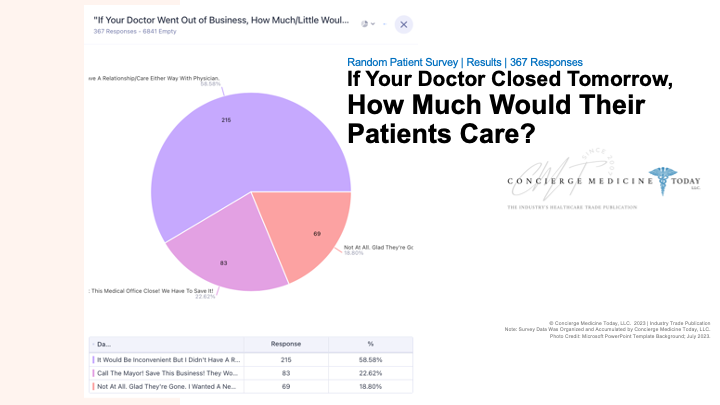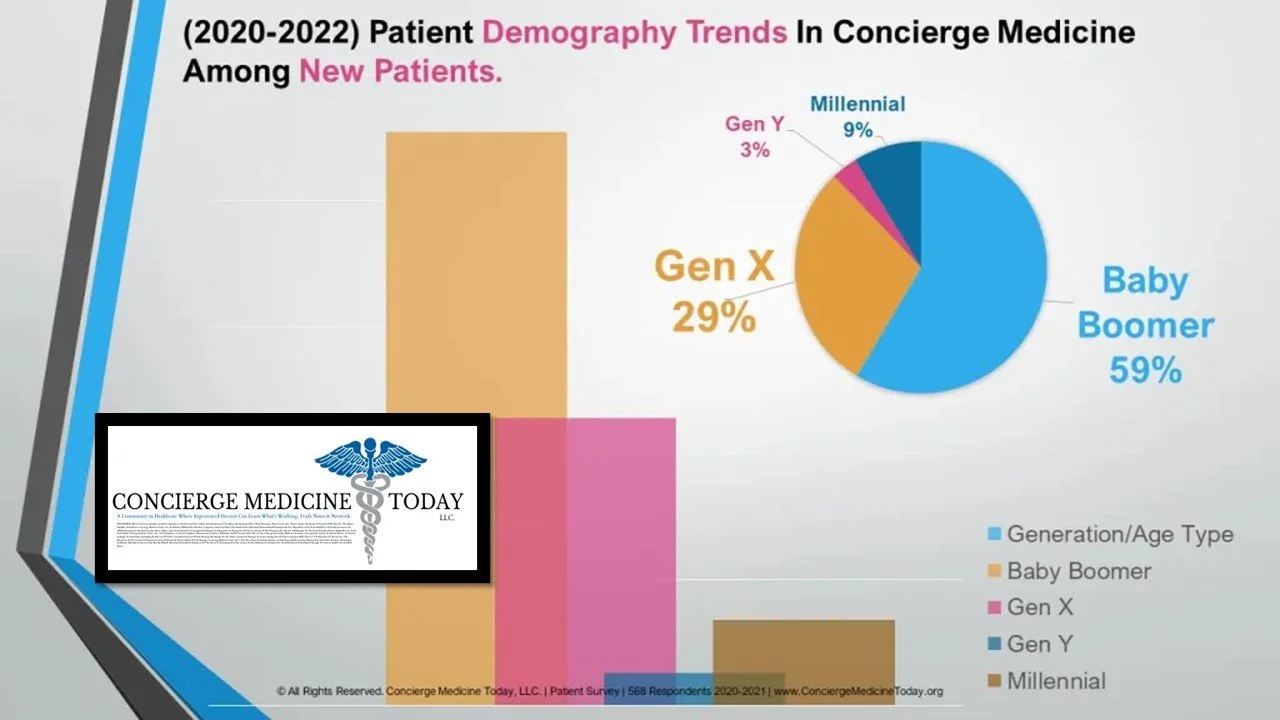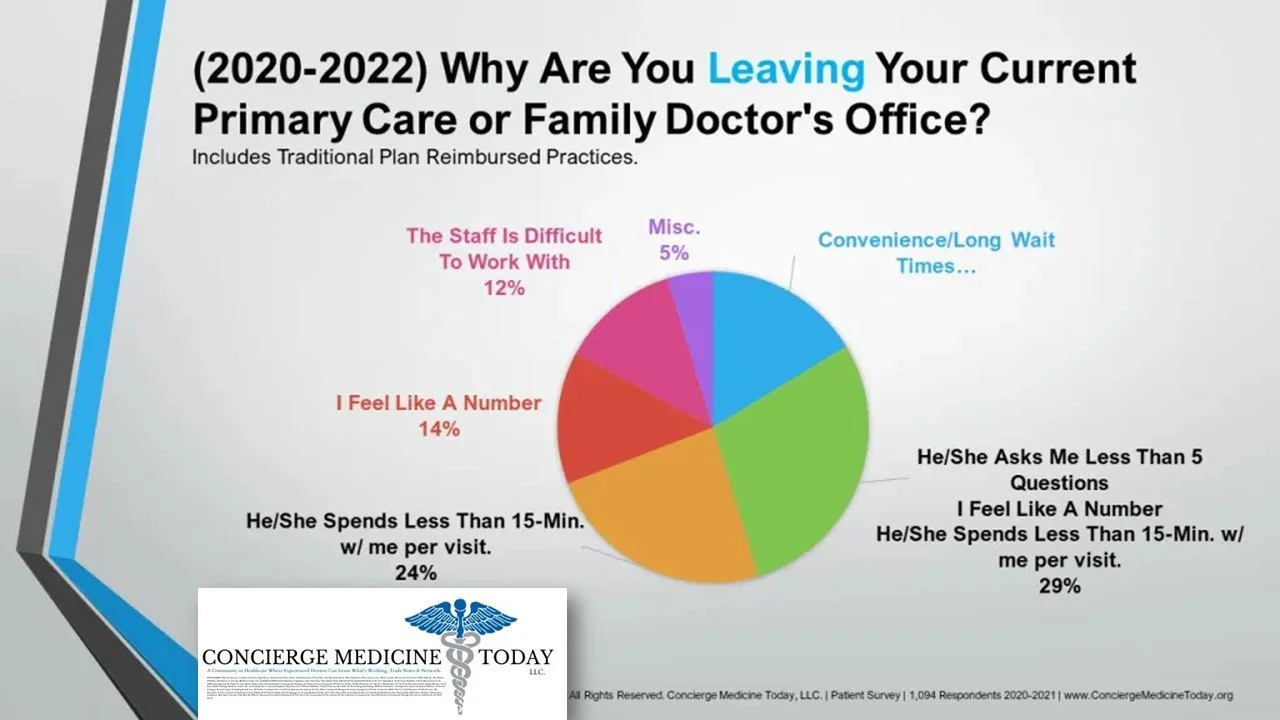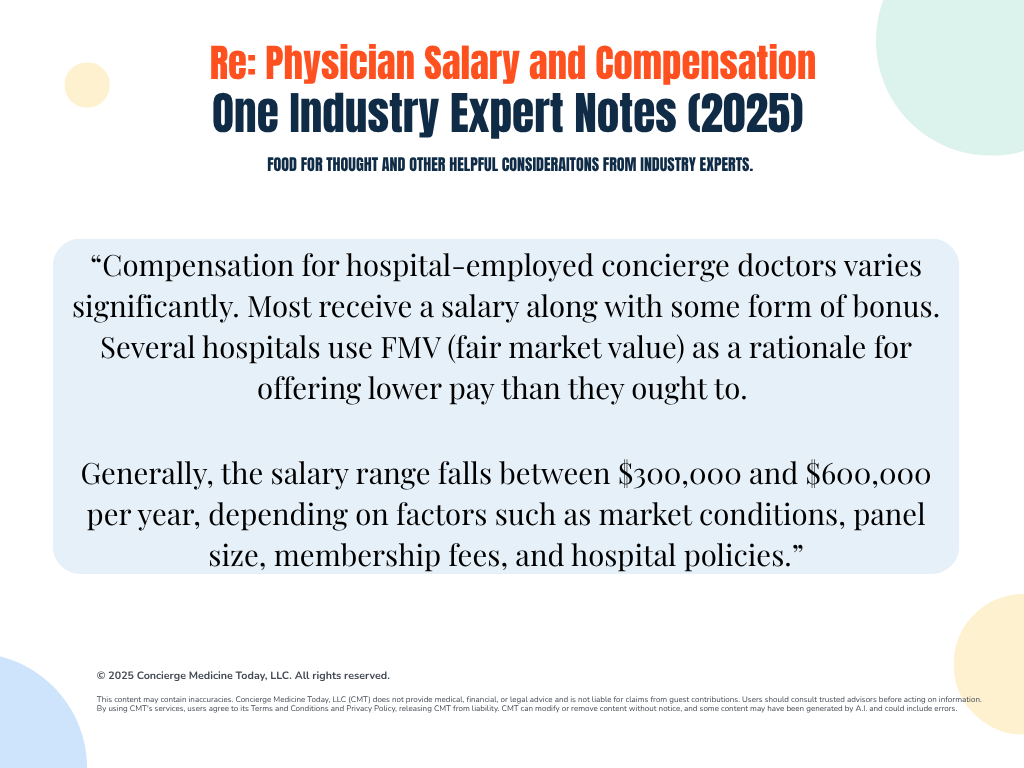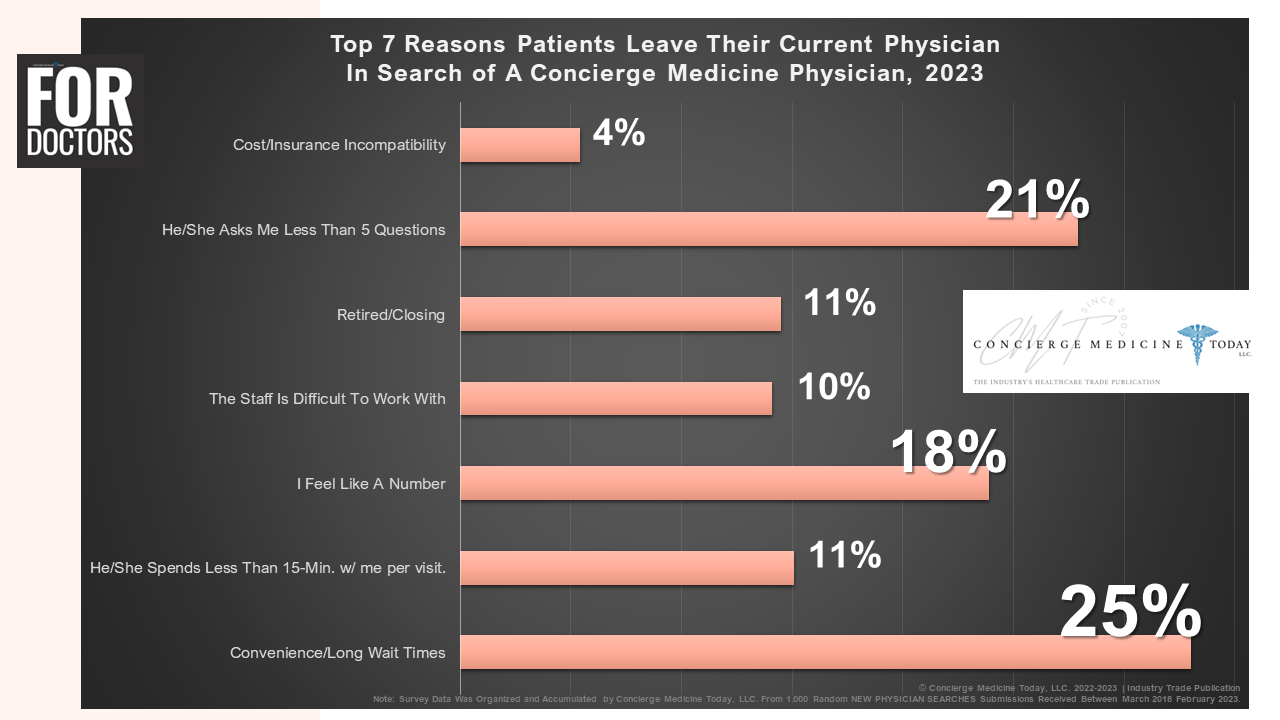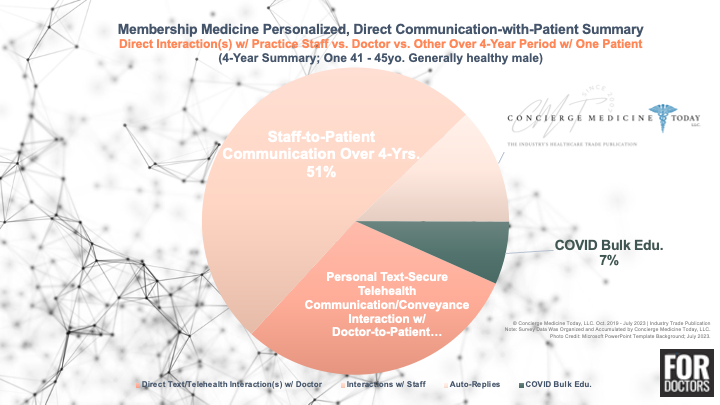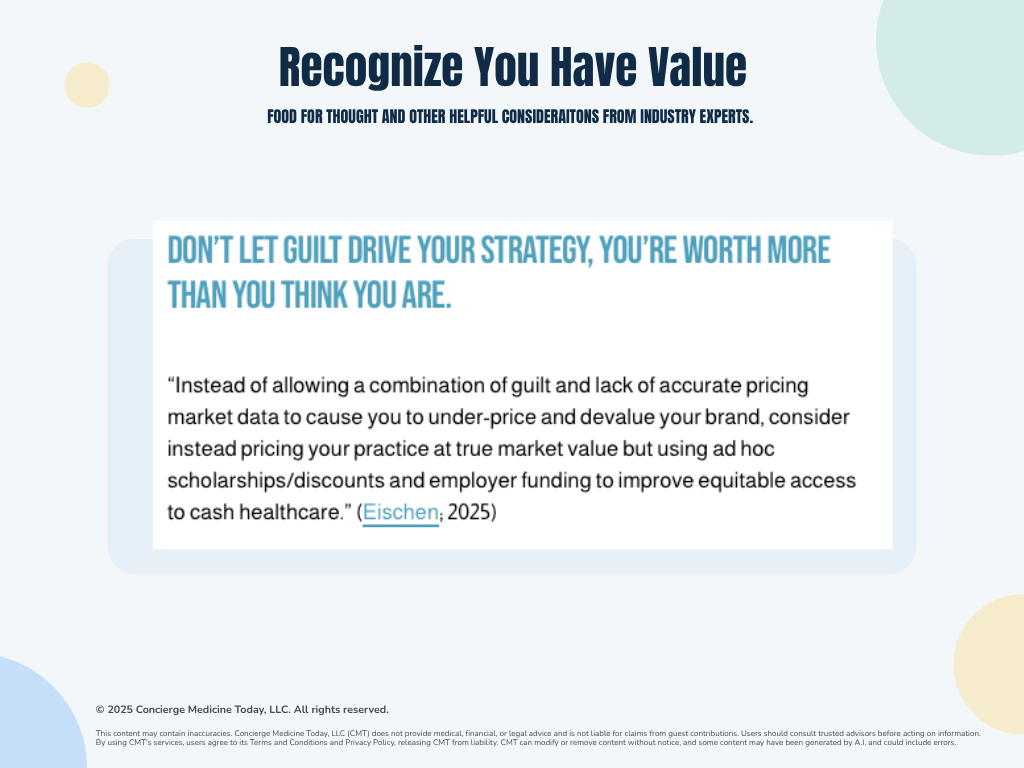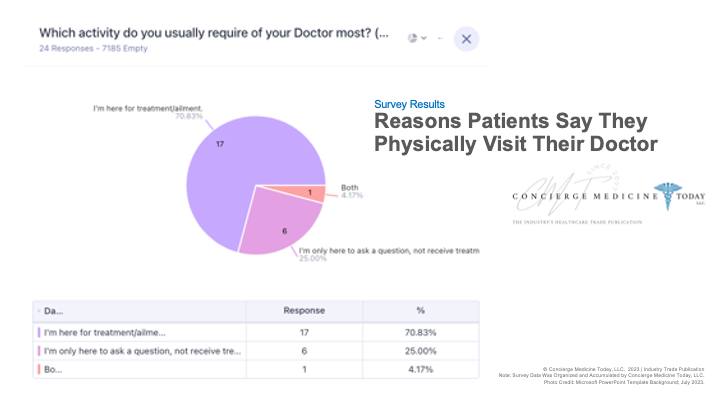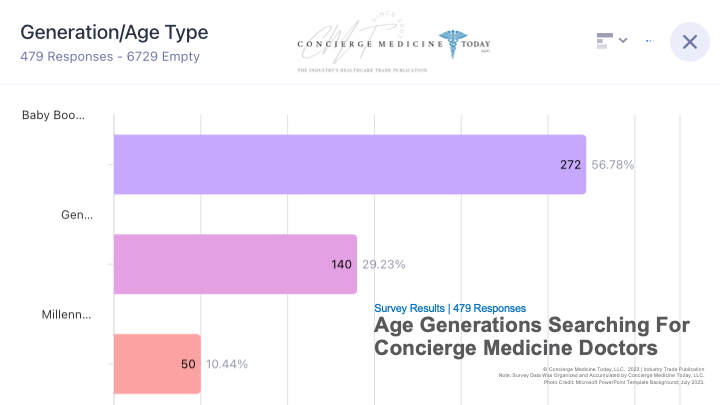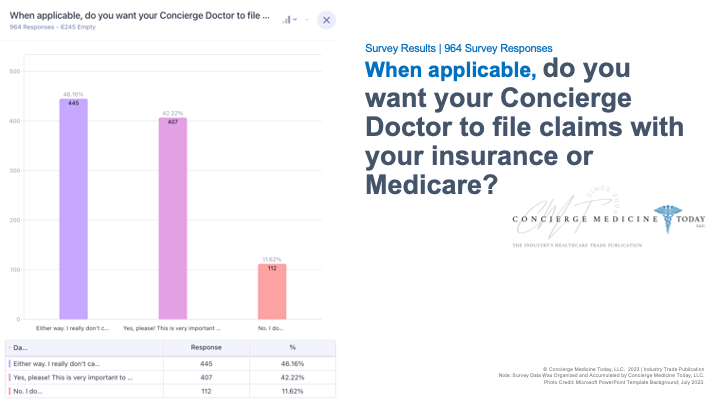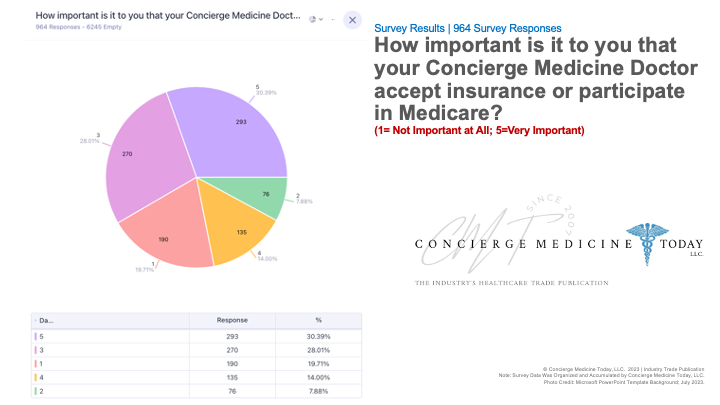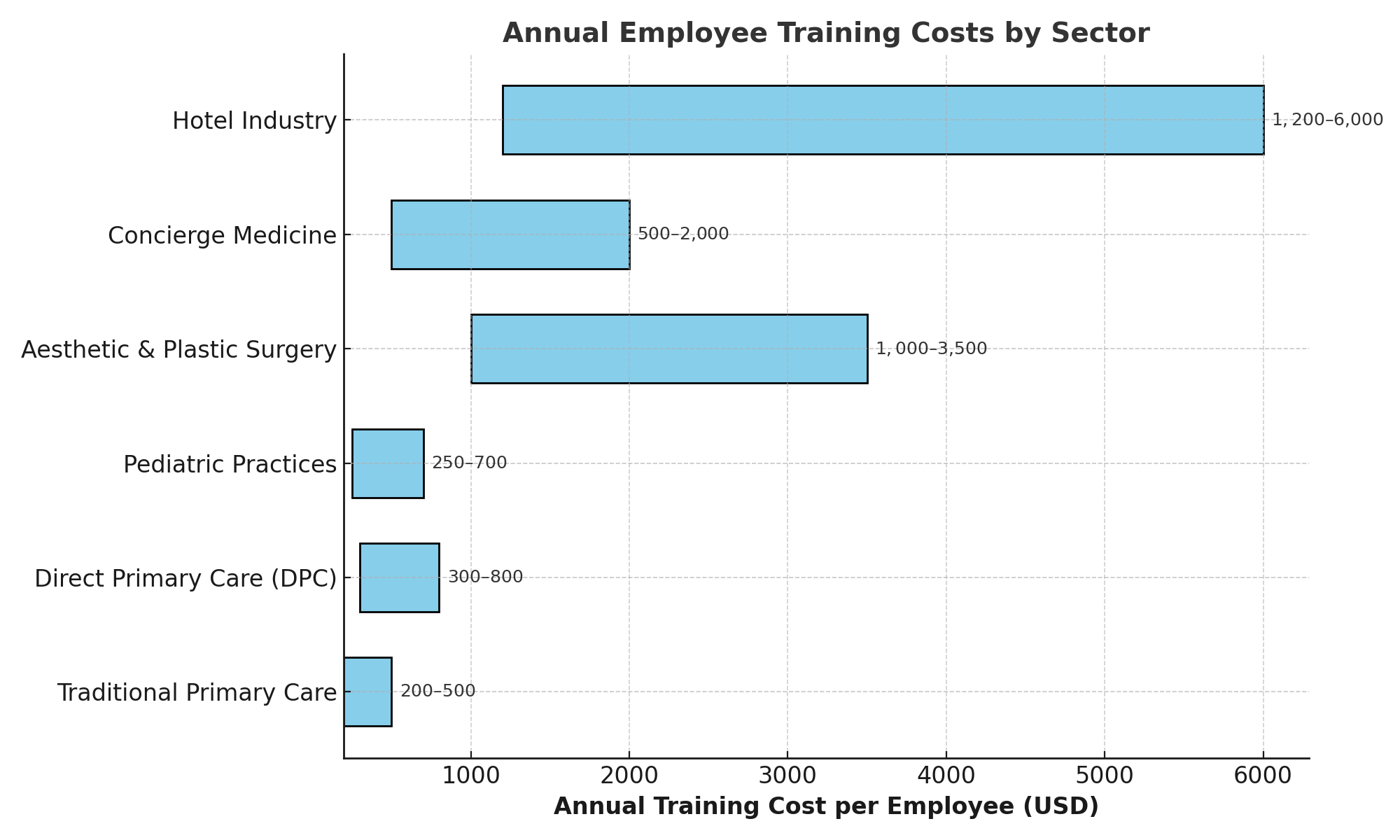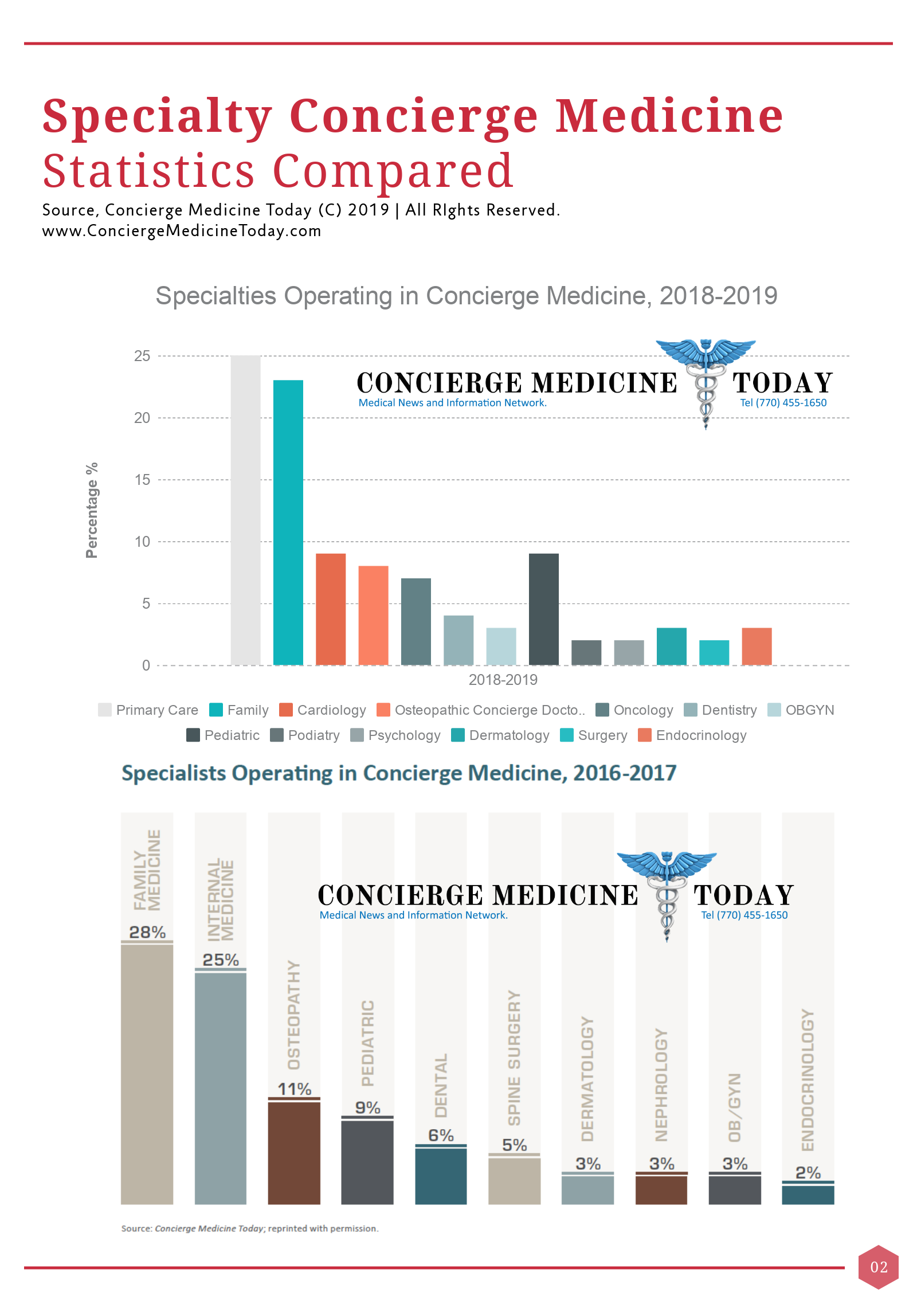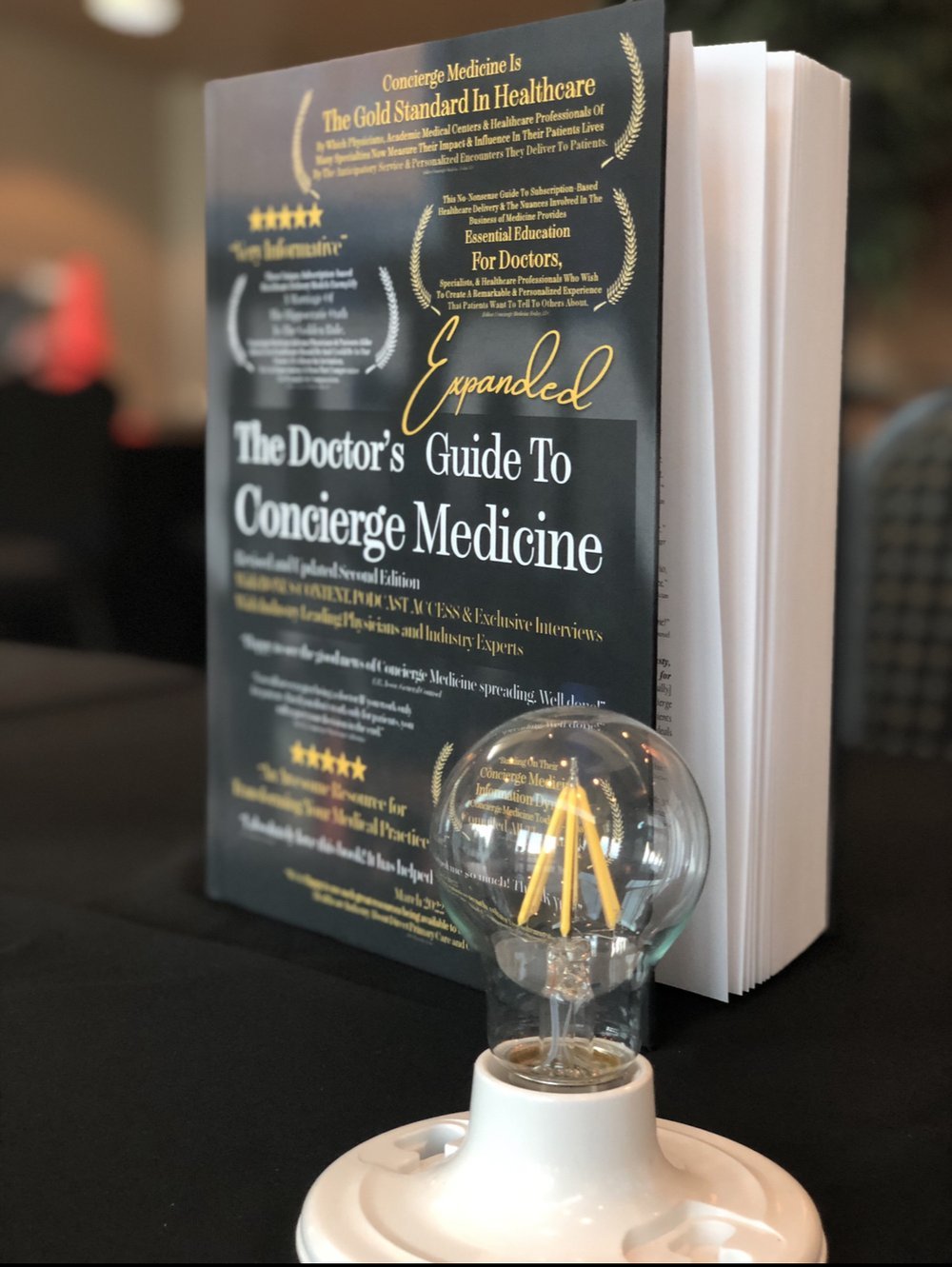
FOR PRACTICES™
Unique Data Points About a Concierge Medicine practice
Concierge Medicine Today has surveyed, interviewed, and tracked trends in the concierge medicine space since 2007, compiling nearly 400 unique data points. The insights below come from online polls and reader engagement—helpful for understanding broad patterns, but not scientific or peer-reviewed. Results may not reflect every practice, so please use them as directional only and conduct your own due diligence.
in 2024, according to Concierge Medicine Today, LLC., polling among 300 Concierge Medicine Physician readers at its online trade publication, a listing of the top six areas practicing within the business model from 2014-2024 whom indicated they currently practice within a Concierge Medicine model do so in the following specialties: Family Medicine = 38%; Internal Medicine = 32%; Osteopathic Physician = 9%; Cardiology = 8%; Nephrology = 3%; and Pediatric = 3%
OVERVIEW OF industry edu RESOURCES FOR PRACTICES™
POLLS
Polling gives us a real-time window into how clinicians and patients think, helping us understand the concierge medicine industry through hyper-specific questions, emerging patterns, and practical, ground-level insights that broader studies often miss. (Learn More)
INFOGRAPHICS
Infographics turn complex, concierge-medicine data into clear, visual insights—making patterns, trends, and hyper-specific findings easier to understand, share, and apply in real-world decision-making. (Learn More)
Concierge Medicine by the Numbers
This section highlights key research, trends, and real-world data that help clinicians and industry leaders understand how concierge medicine impacts patient outcomes, practice sustainability, and the evolving healthcare landscape. (Learn More)
PEER PERSPECTIVES
Peer Perspectives features years of clinician-to-clinician insight curated by Concierge Medicine Today, offering real voices and real lessons from the concierge medicine community. (Read More)
Specialty Perspectives
These specialty FAQs offer clinicians clear, practical insight into how concierge medicine is expanding across specialties, what physicians are asking, and what steps help doctors prepare, transition, and thrive in membership-based models. (Read More)
C-SUITE OBSERVATIONS
A curated collection of real-world concierge medicine C-Suite perspectives gathered by Concierge Medicine Today over the years to help clinicians learn from proven models and practical experience. (Read More)
LEGAL EXPERTS’ COMMENTARY
A curated overview of legal wisdom and real-world considerations every concierge medicine clinician should understand. (Read More)
HISTORY AND TRENDS
A clear look at concierge medicine’s origins and the trends shaping its future. (Read More)
Expert Guidance Series
A collection of expert conversations, perspectives, and informational resources from Concierge Medicine Today that helps clinicians better understand the business, regulatory, and operational landscape of concierge medicine. (Watch and Listen Now)

POLLING
Polling gives us a real-time window into how clinicians and patients think
Polling gives us a real-time window into how clinicians and patients think, helping us understand the concierge medicine industry through hyper-specific questions, emerging patterns, and practical, ground-level insights that broader studies often miss.
Annual Salary of a Concierge Doctor? (2025)
Do you integrate additional testing that would be deemed “longevity” focused?
20 Years After Opening Your Concierge Practice, More or Less Satisfied Than Practicing In A Traditional Manner?
Us of A.I. Scribes
Preferred Methods for Physician Burnout Solutions
Marketing to Patients in Concierge Medicine
Monthly Renewal Trends in Concierge Medicine
How many Concierge Doctors personally contact their patients with test results, recommendations, next steps and/or let their staff return these calls?
Doctors, how many handwritten thank you notes or handwritten notes do you write to Patients per month?
How Did You Finance (Startup) of Your Concierge, Membership Medicine Practice? (Choose all that apply)
How many patients per day do you typically see?
Sports Physicals and Common Immunizations
Do you give yourself a raise each year, even if it’s just $1?
Amount of Business education you received?
How long until you retire from medicine altogether?
Referring a Patient for Surgery?
Types of Specialties in Concierge Medicine (2024)
Are you contracted as an "in-network" provider w/ insurance companies?
Generational Demographics In Concierge Care
Average Cost of a Concierge Medicine Subscription (2024-2026)
How Long Do Patients Stay Under The Care of Their Concierge Medicine Physician?
Your Longest Patient Visit In Concierge Medical Care?
After Converting A Practice To A Concierge Medical Practice, What Is The 1st Thing To Change In Their Practice ? (Please Check All That Apply)
How many patients end up later enrolling in your practice but did not sign-up at first?
Video Consults Conducted Per Day?
Exam Room Questions: Before vs. After Entry Into Concierge Medicine
Do you have a Will, POA or Healthcare Directive?
Time spent per day returning emails in your Concierge Medicine practice?
Time of the day most patients call, text you in your Concierge Medicine practice?
Average Wait Time In Concierge Medicine?
Do you offer your services to patients on a monthly subscription or annual membership basis?
Combined Annual Household Income of Avg Patient
Selling Your Practice and Retiring: Where/To what type of entity are you planning to sell or getting offers from?
Cost of Marketing to Acquire One New Patient?
Doctors + Staff: How Do You 'Measure' Patient Satisfaction In Your Practice?
The Most Common Types of Calls You Receive Each Day From Your Concierge Patients?
Staffing Your Concierge Medicine Practice: 300 Patients
Doctors, how often do you get asked to do pro bono work (or just work for free) among your friends or family?
How many of your Patients do not have health insurance?
How do you manage missed appointments in your Concierge Medicine practice?
How many text messages do you receive per day on average in your concierge medicine practice?
How many additional patients do you need to have a full patient panel (on average) in your concierge medicine practice?


“Ten years ago, concierge medicine was mostly a primary care story. Today, cardiologists, endocrinologists, OB-GYNs, gastroenterologists, and even oncologists are adopting the model. It’s no longer just a business model—it’s becoming a mindset across medicine. Concierge medicine physicians have found a more sustainable pace in their practice model whereby they see more clearly that excellence, regardless of it's form, in healthcare, it isn’t just clinical skill; it’s dignity, attention, timeliness, and clear communication—those aren’t extras, they’re expectations every patient has today. That’s why concierge medicine from my seat on the bus is becoming the new reference point. That’s why concierge medicine is quickly becoming the standard others are measured against. The future belongs to leaders who remove every unnecessary obstacle for the patient and build systems that make servanthood and gratitude for the patient in healthcare repeatable. ”
— Editor-in-Chief, Concierge Medicine Today/Host, The DocPreneur Leadership Podcast
SPECIALTY FAQs
*
SPECIALTY FAQs *
Q: To what extent is concierge practice making inroads into specialties?
“Ten years ago, concierge medicine was mostly a primary care adaption story. Today, cardiologists, endocrinologists, OB-GYNs, gastroenterologists, and even oncologists are adopting a compliant business model. And, it’s actually no longer just a practice model—it’s becoming a mindset across medicine. We've observed over the years that concierge medicine physicians have found a more sustainable pace in their practice model whereby they see more clearly that excellence, regardless of it's form, in healthcare, it isn’t just learned and applied clinical skill; it’s also about dignity, attention, timeliness, and clear communication with patients and team members—those aren’t extras, they’re expectations every patient has today. That’s why concierge medicine from our seat on the bus is becoming the new reference point. It’s also why concierge medicine has quickly become from our vantage point the standard others working in healthcare are measured against. The future belongs to physician whom are leaders and whom remove every unnecessary obstacle for the patient and build systems that make servanthood and gratitude for the patient in healthcare repeatable.”
Q: What’s the prevalence of concierge medicine in the U.S.?
A: “Concierge medicine may be small in size, but it’s big on purpose,” notes the industry’s trade publication Editor-in-Chief at Concierge Medicine Today. “While industry sources note year after year that fewer than 2% of all licensed U.S. doctors practice in some version of subscription-based healthcare delivery model—(that’s about 8,000 to 12,000 practices in the U.S.— at least a quarter of those are now specialists. We’ve also observed incremental growth in adoption and entry into these models and it’s been steady at what we hear is about 4–7% a year — some would say higher but we like to stay realistic, not evangelistic. So while concierge medicine is still a small percentage of the 1.1 million U.S. physicians, it’s quickly becoming the new reference point—the model others are measured against.
Q: What are the most common questions physicians ask about moving into concierge practice?
“The three biggest questions physicians ask us are: Can this work for me? How do I tell my patients? What happens to my workload? Underneath each one is a deeper question: Am I being the best doctor I can be for my patients? We then usually encourage them by saying 'It's no longer about being the best Doctor, Specialist, Nurse, Practice Administrator, etc., in the world anymore, it's about being the best Doctor for the world, for your patients and for your local community.'”
Q: Which career stages are most suitable?
“We’ve seen concierge medicine succeed in every career stage—early-career doctors building a foundation is usually the toughest but it has worked for some, mid-career physicians who want to reclaim balance and go deeper into specific conditions with their patients, and late-career doctors choosing to finish well, find a sustainable pace and yet still want to dive deeper into healthcare's more complex questions with their patients. One concierge medicine physician said to me years ago, 'I still work long hours and into the night, I just use my time differently now and I'm a lot happier ... and so are my patients, team and family members.”
Q: What makes it different?
A: “What sets this industry apart isn’t the model, it’s the mission: remove every unnecessary obstacle FOR the patient and build systems that make servanthood in healthcare repeatable,” says the Editor-in-Chief at Concierge Medicine Today. “At the end of the day, healthcare isn’t just about medicine—it’s about people. You see excellence in healthcare isn’t just clinical skill anymore; healthcare from the patients perspective is about dignity, attention, timeliness, and clear communication—those aren’t extras, they’re expectations. That’s why we see concierge medicine becoming the new reference point in healthcare — it’s what others are not looking up to. We see concierge medicine quickly becoming the standard others are measured against. The mission and a version of the membership medicine model now create space for what patients really want: time, dignity, and attention. With smaller panels—225–550 vs. the 2,500–5,000 of traditional plan reimbursed practices—healthcare in these practices feels more personal and less transactional. It tells me that this isn’t a fad—it’s a long-term structural change in how care could be and should be delivered.”
Q: Which specialties are an ideal fit, and why?
“The specialties that fit best aren’t defined by procedures, but by relationships. Anywhere patients need time, clarity, and ongoing management—cardiology, women’s health, pediatrics, oncology—concierge medicine works. The specialties entering concierge medicine now represent a good percentage of the practices out there today — it's hard to say exactly how many because this is a business model but we're seeing more and more specialties enter this space especially within the past decade and that's encouraging for patients and for Doctors and other healthcare practitioners.”
Q: How much time should physicians plan to prepare, and what are the early steps?
“The average runway I'd estimate is 12–18 months. The first steps aren’t about contracts or spreadsheets—they’re about finding clarity: know your why, talk with your family, surround yourself with a trusted business advisory and consulting team, and learn from a few respected colleagues who’ve made the switch but have humility and are not evangelistic about any particular model of practice. We often encourage Doctors to please do their homework, write down all of their detailed questions and go find the answers with the experts who can put your mind at rest. We often repeat something we read a couple of years ago in a business book that practitoners considering this space find encouraging: ''This learning curve and transitional process won't be easy, but you didn't sign up for easy, you signed up for worthwhile.'”
Q: Are there personality traits that make for successful concierge physicians?
“The physicians who thrive in concierge medicine share four traits: curiosity about patients, humility as leaders, gratitude for those they serve, and a heart for their community. At the end of the day, healthcare isn’t just about medicine—it’s about people. Patients may forget the procedure, the paperwork or what the doctor actually said earlier that day in the exam room, but they’ll never forget how you made them feel.”

MORE FAST FACTS about concierge medicine practices
How Concierge Medicine Improves Patient Outcomes and Experiences
The combination of readily accessible physicians and ongoing engagement contributes to a positive care experience. One 2019 survey reported a 98-percent satisfaction rate for patients, with 80 percent of physicians describing their morale as “very positive.” (Eastwood; 2022)
In addition, peer-reviewed research has shown a positive impact on clinical outcomes and care costs. A 2020 review of commercially insured patients with access to One Medical found a 45 percent reduction in total health spending, including a 54 percent reduction in specialty care costs. Meanwhile, a 2018 paper found that MDVIP physicians succeeded in reducing risk of cardiovascular disease in more than two-thirds of patients. Additional research has linked concierge medicine with an 80-percent reduction in hospital admissions among Medicare beneficiaries. (Eastwood; 2022)
“The model works well for consumers,” Jorgensen says. “Yes, they spend out of their own pocket, but the model does improve clinical outcomes and lowers costs.” (Eastwood; 2022)
A refreshing change for patients and physicians
“It’s evident that the healthcare delivery marketplace requires a transformation,” states the Editor-in-Chief of Concierge Medicine Today, the leading publication in the industry. “This could involve reimagining the executive healthcare model as some have already done, establishing pay-as-you-go or cash-only primary care clinic, or introducing subscription plans that encompass services not covered by traditional insurance or Medicare. The reasoning behind these models is unmistakable. Ultimately, these pioneering subscription solutions provide a refreshing change for the upcoming generation of patients, and I truly believe they will aid both doctors and patients in navigating the future of our healthcare system, fostering connection rather than division. It is no longer about being the best Doctor in the world anymore, it’s about being the best Doctor FOR the world, FOR your patients and FOR your local community!”
~Editor-in-Chief, Concierge Medicine Today
THESE ARE business model(s)
“When you look at the big picture and zoom out for a moment,” says the Editor-in-Chief, “It should be noted that these figures only represent an insignificant percentage of the roughly 1,101,735 total licensed physicians* in the U.S., (Kaiser Family Foundation; Jan 2025) that actively practice in one of these versions of cash-pay, subscription or membership-based medicine today. Industry experts and observers tell Concierge Medicine Today that growth in the provision of subscription private medicine services continues to be primarily in internal medicine and family medicine, although more and more specialty physician and health systems movement is on the rise. Concierge Medicine Today also cautions that there is no way that Internet searches and polling, maps, or the Internet can or will result in an accurate head count of these subscription-based and cash-pay business models. Therefore, it is left up to industry leaders, consultants, legal examiners, physicians and thought experts in the space, to accurately estimate and educate others about the history, trends, pros, cons and future of this innovative medical space.”
Growth Expectations
In an article by HealthTech written by Brian Eastwood in December of 2022, Grand View Research estimates that the concierge medicine market will grow more than 10 percent annually each year until 2030. The consultancy cites several factors, including a continued increase in patient volume that started during the pandemic, greater financial stability due to limited reliance on insurance reimbursement, and improved quality of life for physicians. (Eastwood; 2022)
However, the industry’s trade publication, Concierge Medicine Today, has a slightly more conservative estimate of 6-7% growth rate year over year, based on industry observations, physician interviews and experts’ outlook.
Future Forecasts + Trends
According to Precedence Research, a worldwide market research and consulting organization in December of 2023 in a press release (click here) published on Globe Newswire, the U.S. concierge medicine market size accounted for USD 6,633.91 billion in 2023 and grew to USD 6,958.51 million in 2024, expanding at a CAGR of 5.70% between 2023 and 2032. The press release by Precedence Research also said the global concierge medicine market size is projected to surpass USD 34.27 billion by 2032, increasing from USD 19.12 billion in 2023 and is expanding at a CAGR of 6.7% from 2023 to 2032 (Precedence Research; 2023).
Services Typically offered
For the cost of the retainer fee, patients benefit from longer in-person visits; hour-long annual wellness exams are not uncommon. In addition, concierge medicine practices typically offer same-day or next-day appointments along with after-hours access to care via phone, text or email. The fee may also cover wellness programs, health coaching and other types of services. Some practices offer discounted services for additional family members. MDVIP, for example, offers care to members’ children until they turn 26. (Eastwood; 2022)
STUDIES and DATA SUPPORTING THE PCM or today’s more contemporary concierge medicine and RELATED VERSIONS OF TODAY’S membership MODEL(s) IN HEALTHCARE
With the trust gap widening between patients and physicians, it was recently found that 60% of primary care physicians feel they need to earn trust back with patients post-pandemic (MDVIP; 2025) and 1 in 3 reaching “burned out” status – on the Patient Frustration Index, which measures common healthcare pain points across major population groups (MDVIP; 2024). What’s even more remarkable is that around half of these practitioners mentioned have been actively learning from currently successful practices, affiliated organizations and pioneering physicians in the field and experimenting with various subscription and membership pricing models of their own. What’s even more encouraging is that data and studies from the industry reveal some surprising findings:
One study from MDVIP shows personalized primary care reduces ER visits, hospitalizations and outpatient expenditures for diabetic population. The study found that the MDVIP model substantially decreases costs in the diabetic population by year five of enrollment in the preventive care program. After the first post-enrollment year, the mean costs continue to rise for the comparison population, while flattening for MDVIP beneficiaries. The study found decreased unplanned hospital admissions, emergency room visits and outpatient expenditures. At year five, MDVIP patients have statistically significant lower Medicare expenditures. These patients also showed increases in primary care office visits, as their physicians spend more time coaching and monitoring their progress (MDVIP; 2020).
Another study notes that personalized preventive care yields decreased costs and better health management. A study in Population Health Management from MDVIP (MD-Value In Prevention) highlights how a primary care model based on personalized preventive care achieves definitive cost savings and improved health management within three years of adoption. The study, appearing in the February 2016 edition of the peer-reviewed journal, reinforces earlier research published in 2012 in the American Journal of Managed Care (AJMC) proving the efficacy of the MDVIP model(MDVIP; 2016).
And finally, another study proves dramatic reduction in hospitalizations and $300 million savings for MDVIP's Personalized Healthcare Model. MDVIP-affiliated physicians have the time to focus on acute, chronic and preventive health issues, and this increased physician contact time results in improved outcomes for patients and ultimately lowers healthcare costs (MDVIP; 2012, 2013).
How would you some experts define today’s more contemporary version of concierge medicine (present day)? For one last industry perspective, a CEO of one of the conversion companies had this to say to Medical Economics when asked ‘How would you define concierge medicine?’ The CEO said “I would define it simply by saying that physicians elect to reduce their patient panels to much more manageable sizes so they can provide the care their patients deserve. Patients who join the practice pay a membership fee either annually, semiannually or quarterly. In exchange for that membership fee, the patients maintain (or gain) that deep, intimate relationship with their doctor, receive the ability to schedule same-day or next-day appointments and have longer, more comprehensive office visits and annual exams. The practice size typically is reduced from 2,000 to 3,000 patients to 300 to 500. The practice becomes more manageable at that size, and as our affiliated doctors tell us, they have the time to think, plan, dig deeper with their patients and really focus on health, wellness and disease management, not just the symptom of the day. I would [also] say, it’s not for every physician. We receive dozens of inquiries every week from doctors all over the U.S. and engage with between 5% to 8% of them. The ideal candidate is a doctor who’s in internal medicine, family practice or another specialty where there is an ongoing physician-patient relationship. Being located in a market where they’ve been practicing for at least five years is also key. Once they have a following of patients and longer-term relationships, they develop a depth of intimacy with their patients. Also important is that the market where they practice has a median household income above a certain level — and let me add that this is not just for wealthy people. A median household income above $75,000 and median household net worth of $250,000 has proven to be sufficient for patients to make this valuable investment in their health. I don’t want anyone thinking this is only for people in Beverly Hills or New York City. So if it’s the right doctor, in the right market, with the right specialty, today physicians must also have high patient ratings on Google and Healthgrades. Due diligence by both the doctor and the concierge medicine management company must be completed and if everything meets expectations; a detailed plan must be constructed. It takes between 90 and 120 days from the signing of the agreement to the time the concierge practice opens. There are many steps before launch including … ongoing patient communication and engagement, developing a customized website, creating a crystal clear message, confirming a vision for the practice, and training the staff.” (Mazzolini; 2023)
Strong Focus on Prevention + Relationship With Patients
"Concierge Medicine practices and programs today are typically known for their focus on prevention and have often curated strong relationships between Patients and the Physician and Patient and the staff. So in essence, staff and Doctors don’t usually have to look at a medical chart to remember your name."
~Editor-in-Chief, Concierge Medicine Today
MORE CONSISTENT COMMUNICATION
“The Concierge Medicine Physician of modern-day today is in my opinion … purposefully more communicative and intentional about blending customer service techniques and social graces into the rhythm of his/her daily medical practice environment which in turn, creates a unique bond between Physician and Patient. Couple that with preventative care conversations and innovative healthcare services and we all have something to lean into. In summary, it's no longer about being the best Doctor in the world anymore, it's about being the best Doctor for the world.”
~Editor-in-Chief, Concierge Medicine Today
PRIMARY DRIVERS OF GROWTH AND INTEREST BY PATIENTS AND PHYSICIANS
FOR PATIENTS: Patient interest is always growing and it’s difficult to calculate but the Physicians we’ve interviewed and talk to every week — it’s because they’re frustrated with the current healthcare marketplace. These subscription models (at all price points) offer patients, families and individuals the convenience, respect, dignity and transparency the traditional, plan reimbursed marketplace isn’t delivering on.
FOR DOCTORS: For Doctors, career satisfaction is very, very high (see below FAQs). These practice models allow the physicians to not have to look at a medical chart to remember the patients name anymore. Don’t get us wrong, they’re still telling us they work long hours in the practice seeing patients and often spend a lot of time on the business side of the practice — but the work in so much more rewarding. Just read some of the FAQs (see below) as well as the Physician comments here and talk to the industry consultants about their experience helping doctors. You can find a list of those resources helping doctors move into these models here.
How Concierge Medicine and Primary Care Differ
The biggest difference between concierge medicine and primary care is the payment model. Concierge practices charge a flat retainer fee, typically collected monthly or yearly. While fees can vary from $1,200 to more than $20,000 per year, the average annual concierge medicine fee tends to be between $1,500 and $2,500 per year, or roughly $125 to $210 per month, according to the concierge practice PartnerMD. (Eastwood; 2022)
ANALYZING THE NUMBERS ACCORDING TO MODELS USED (circa 2025)
“While small in number, these practice models are big in purpose,” notes the Editor-in-Chief of the industry trade publication, Concierge Medicine Today. “We estimate that fewer than 2% of U.S. doctors—roughly 8,000–12,000 practices—operate in concierge medicine, direct primary care, retainer-based, subscription, or executive health models. Each of these models are distinct in their own right, yet together we believe they’re growing about 4–7% a year because they’re designed to be for patients—delivering excellence through stronger relationships, higher satisfaction, and better retention for both physicians and patients [Concierge Medicine Today, Apr 2025; DPC Frontier, 2024; Kaiser Family Foundation, Jan 2025].”
Zooming In On Only the Subscription, Membership Model(s)
THE MEMBERSHIP MEDICINE INDUSTRY (circa 2025): According to industry sources from within the Concierge Medicine space, Concierge Medicine Today reports that today there are an estimated 3,000 to 4,000 (total) doctors embracing some version [or iteration] of a subscription-based healthcare delivery approach. Note, it’s estimated that more 25% of that figure (i..e. 4,000) represents specialty practices, probably more but these are conservative estimates. (Concierge Medicine Today; Apr 2025)
Zooming Out On National Impact
BIG NOISE, LITTLE TO NO IMPACT ON ANY PHYSICIAN SHORTAGE (circa 2025): According to industry sources from within the Concierge Medicine space, Concierge Medicine Today reports that it should be noted that these figures (i.e. 4,000 doctors/practices) still only represent a paltry percentage (i.e. 0.363%) of the roughly 1,101,735 total licensed physicians* in the U.S., (Kaiser Family Foundation; Jan 2025) that actively practice in one of these versions of cash-pay, subscription or membership-based medicine today. (Note: KFF data includes currently active allopathic physicians (MDs) and osteopathic physicians (DOs). Special data request for information on active state licensed physicians from Redi-Data, Inc, January 2025 (Kaiser Family Foundation; Jan 2025)
Zooming In On Impact On Primary Care
STILL BIG NOISE but LITTLE TO NO IMPACT ON ANY PRIMARY CARE PHYSICIAN SHORTAGE CRITIQUES (circa 2025): According to industry sources from within the Concierge Medicine space, Concierge Medicine Today reports that these figures (i.e. 3,000. primary care practices) still only represent a minute percentage (i.e. 0.560%) of the roughly 535,012 total licensed primary care physicians* in the U.S., (Kaiser Family Foundation; Jan 2025) that actively practice in one of these versions of cash-pay, subscription or membership-based medicine today. (Note: KFF data includes currently active allopathic physicians (MDs) and osteopathic physicians (DOs). Special data request for information on active state licensed physicians from Redi-Data, Inc, January 2025 (Kaiser Family Foundation; Jan 2025)
Why the numbers conundrum?
This sector of healthcare is quite niche, making it akin to spotting schools of fish when you encounter these practices in the wild! Since cash-pay, subscription-based, membership, and concierge medicine are simply business models rather than distinct medical specialties, there is no federal registry or official national database to verify these physicians' numbers. Consequently, as noted by the Editor-in-Chief of the industry’s trade publication, accurately estimating a specific figure becomes challenging. Nevertheless, despite the public relations hurdles that "concierge medicine" has faced over the last two decades—mostly from within the healthcare industry rather than from potential or current patients—it is estimated by industry leaders that the interest in some form of subscription-based or cash-pay healthcare is increasing at a rate of approximately 6-7% annually.
According to Concierge Medicine Today, long-term data regarding these specific subscription-based patients is still being gathered. Marketplace consultants and physicians advocate for further analysis of this information. More research to validate these prevalent observations should be examined and published. Based on year-over-year observations, practices that operate on a cash-pay subscription or membership model are reporting patient retention and care levels that meet or surpass those of traditional primary care and family practices.
Of additional interest, and largely reflected in the estimated figures, data from Medscape reveals that in 2020, only 17% of clinicians utilized cash-only, concierge, or direct-pay primary care models, based on a survey of over 17,000 healthcare professionals. Among these, primary care providers (PCPs) represented the highest percentage of those accepting cash payments, with 10% of practices implementing a flat monthly fee for unlimited services.
Are 'concierge' or 'subscription' models in healthcare classified as part of the self-pay and cash-only marketplace?
"In short, yes! However, this is primarily due to the key term 'self-pay,'" remarked the Editor-in-Chief of Concierge Medicine Today. "We're observing an increase in self-pay and cash-only practices within the U.S. healthcare system."
Why the reduced Patient Panels, does this really allow for more focus and attention on the patient?
"Healthcare is a process to be sure, but the patient should never feel processed. More often than not, concierge medicine practices have reduced patient panels of 225-550 to that compared to the traditional, plan reimbursed practices which usually boast 2,500-5,000."
~Editor-in-Chief, Concierge Medicine Today
Are self-pay and cash-only practices CONSIDERED PART OF OR within the ‘concierge’ or ‘subscription’ marketplace?
“In summary, the answer is no. This is primarily due to the qualifying term ‘subscription,’” explains the Editor-in-Chief of Concierge Medicine Today. “In the past, sources indicated that there exists an unknown number of independent physicians (or practitioners) working across the U.S. who practice some variation of cash-only or self-pay healthcare, yet are not associated with any marketing label, organization, consulting agency, or brand as we understand them today. While this is likely accurate when examining other facets of the self-pay and cash-pay healthcare landscape, these practitioners technically do not align with the three main subscription-based healthcare delivery models that are predominantly operational in today’s market. Therefore, previous figures estimating these programs in the tens of thousands likely included those self-pay and cash-only practitioners — however, we now observe that the subscription-based healthcare delivery market is robust enough to stand independently and be recognized on its own.”
Are there A LOT oF ‘self-pay’ and ‘cash-only’ healthcare practices in the U.S. today that do not include subscriptions or memberships in their services?
"It's also challenging to pinpoint a specific number," stated the Editor-in-Chief of Concierge Medicine Today. "However, we have observed an increase in the number of self-pay and cash-only healthcare practices across the country. Here's what we've learned over the years about this landscape, which differs from the subscription-based healthcare model: Approximately 13% of family physicians now utilize cash-pay models (American Academy of Family Physicians; 2021); a survey indicates that 43% of practices provide cash payment options (MGMA; 2020); nearly 30% of Americans believe cash payments help reduce costs (Journal of Health Economics; 2022); and specialties like dermatology are increasingly adopting cash-only models due to their simplicity (Health Affairs; 2019)."
SETTING AN EXAMPLE OTHERS IN HEALTHCARE
“Sometimes exactly what these (present-day) Doctors and practices do, the public relations and messaging elements often fall into the category of ‘Totally Misunderstood,’” said Editor-In-Chief of Concierge Medicine Today, “Today's version of Concierge Medicine Physicians are highly entrepreneurial and respected by their peers. Regardless of how some might feel about the optics or public relations conundrum over the years, they now set the example FOR others at health systems, large, medium and small practices alike for how healthcare could be and should be delivered. And, they’re usually involved and upstanding members within their local community, both professionally and personally. According to Concierge Medicine Today sources, concierge medicine continues to thrive in metropolitan and suburban markets that serve repeat patients ... whereby patients who utilize such services are visiting the practice more often. Usually, rural primary care and countryside practices are not suitable geographies for concierge medicine practices or programs due in large part to a geographically disbursed patient population within these rural or agriculture settings. Like any business, economic factors must be considered and rural concierge medicine programs and practice have overhead. Therefore, these types of membership or subscription-based healthcare delivery models typically support a frequently served, familial and/or repeat patient population that requires persistent attention and/or continuous management and communication for ongoing chronic conditions vs. those practices and medical care environments that serve acute care issues (eg. the one and done patient visit).”
~Editor-in-Chief, Concierge Medicine Today
Physician Satisfaction, 10-Years Later
According to Concierge Medicine Today, LLC, the industry trade publication, their online polling results related to this topic found a trend that 95% of Physicians said "Yes!, they are more satisfied than ever before with their decision to move into some version of concierge medicine!" To this day, career and also patient satisfaction in concierge medicine remains extremely high. Additionally, other industry data reflects these trends. According to a news release published by Yahoo! Finance on November 27, 2024, it stated that … The two most rewarding aspects of converting to concierge medicine were additional time to develop relationships with patients (90%), and a better work-life balance with personal and family time (65%). (Specialdocs Consultants; 2019, 2023).
industry FAQs
*
industry FAQs *
Q: To what extent is concierge practice making inroads into specialties?
“Ten years ago, concierge medicine was mostly a primary care adaption story. Today, cardiologists, endocrinologists, OB-GYNs, gastroenterologists, and even oncologists are adopting a compliant business model. And, it’s actually no longer just a practice model—it’s becoming a mindset across medicine. We've observed over the years that concierge medicine physicians have found a more sustainable pace in their practice model whereby they see more clearly that excellence, regardless of it's form, in healthcare, it isn’t just learned and applied clinical skill; it’s also about dignity, attention, timeliness, and clear communication with patients and team members—those aren’t extras, they’re expectations every patient has today. That’s why concierge medicine from our seat on the bus is becoming the new reference point. It’s also why concierge medicine has quickly become from our vantage point the standard others working in healthcare are measured against. The future belongs to physician whom are leaders and whom remove every unnecessary obstacle for the patient and build systems that make servanthood and gratitude for the patient in healthcare repeatable.”
Q: What’s the prevalence of concierge medicine in the U.S.?
A: “Concierge medicine may be small in size, but it’s big on purpose,” notes the industry’s trade publication Editor-in-Chief at Concierge Medicine Today. “While industry sources note year after year that fewer than 2% of all licensed U.S. doctors practice in some version of subscription-based healthcare delivery model—(that’s about 8,000 to 12,000 practices in the U.S.— at least a quarter of those are now specialists. We’ve also observed incremental growth in adoption and entry into these models and it’s been steady at what we hear is about 4–7% a year — some would say higher but we like to stay realistic, not evangelistic. So while concierge medicine is still a small percentage of the 1.1 million U.S. physicians, it’s quickly becoming the new reference point—the model others are measured against.”
Q: Step-by-Step Reality MATH Check 📊
KFF (as of Sept. 2025):
1,105,148 professionally active physicians in the U.S.
(Source: Sept 2025, KFF State Health Policy Data)2% of that total = ~22,100 physicians.
(As noted above) Concierge Medicine Today notes 8,000–12,000 concierge practices.
If each practice averages 1.2 to 1.5 physicians, that translates to roughly 9,600–18,000 concierge physicians, which is well within the “fewer than 2%” range (≈0.9%–1.6% of all U.S. doctors).
So in summary and mathematically speaker, yes — the above statement(s) we believe are mathematically sound and aligns with KFF’s national Professionally Active Physicians and active state licensed physicians from Redi-Data, Inc, September 2025 and our industry sources perpesctive(s).
In short: 📊 Practices ≠ Physicians — and we (CMT) intentionally stay on the conservative side to keep our reporting realistic, not evangelistic — and aim to provide credible estimates.
Q: What are the most common questions physicians ask about moving into concierge practice?
“The three biggest questions physicians ask us are: Can this work for me? How do I tell my patients? What happens to my workload? Underneath each one is a deeper question: Am I being the best doctor I can be for my patients? We then usually encourage them by saying 'It's no longer about being the best Doctor, Specialist, Nurse, Practice Administrator, etc., in the world anymore, it's about being the best Doctor for the world, for your patients and for your local community.'”
Q: Which career stages are most suitable?
“We’ve seen concierge medicine succeed in every career stage—early-career doctors building a foundation is usually the toughest but it has worked for some, mid-career physicians who want to reclaim balance and go deeper into specific conditions with their patients, and late-career doctors choosing to finish well, find a sustainable pace and yet still want to dive deeper into healthcare's more complex questions with their patients. One concierge medicine physician said to me years ago, 'I still work long hours and into the night, I just use my time differently now and I'm a lot happier ... and so are my patients, team and family members.”
Q: What makes it different?
A: “What sets this industry apart isn’t the model, it’s the mission: remove every unnecessary obstacle FOR the patient and build systems that make servanthood in healthcare repeatable,” says the Editor-in-Chief at Concierge Medicine Today. “At the end of the day, healthcare isn’t just about medicine—it’s about people. You see excellence in healthcare isn’t just clinical skill anymore; healthcare from the patients perspective is about dignity, attention, timeliness, and clear communication—those aren’t extras, they’re expectations. That’s why we see concierge medicine becoming the new reference point in healthcare — it’s what others are not looking up to. We see concierge medicine quickly becoming the standard others are measured against. The mission and a version of the membership medicine model now create space for what patients really want: time, dignity, and attention. With smaller panels—225–550 vs. the 2,500–5,000 of traditional plan reimbursed practices—healthcare in these practices feels more personal and less transactional. It tells me that this isn’t a fad—it’s a long-term structural change in how care could be and should be delivered.”
Q: How does the concierge model affect the doctor–patient relationship?
“Fewer patients doesn’t mean less care; it means more intentional care, longer careers, and patients who finally feel seen,” adds Concierge Medicine Today’s Editor. “Over the years, when we’ve asked experienced concierge physicians what’s changed for them, they don’t talk about revenue or time off — they talk about joy. These doctors are rediscovering why they started, again. And as one concierge medicine physician reminded us just last month at our industry conference, ‘When the doctor’s fulfilled, the patient benefits too. You can’t fake that kind of energy in an exam room.’ These models are raising the bar for satisfaction on both sides of the room — doctors are staying in practice longer, and patients are reminded what it feels like to be genuinely cared for.”
Q: Which specialties are an ideal fit, and why?
“The specialties that fit best aren’t defined by procedures, but by relationships. Anywhere patients need time, clarity, and ongoing management—cardiology, women’s health, pediatrics, oncology—concierge medicine works. The specialties entering concierge medicine now represent a good percentage of the practices out there today — it's hard to say exactly how many because this is a business model but we're seeing more and more specialties enter this space especially within the past decade and that's encouraging for patients and for Doctors and other healthcare practitioners.”
Q: How much time should physicians plan to prepare, and what are the early steps?
“The average runway I'd estimate is 12–18 months. The first steps aren’t about contracts or spreadsheets—they’re about finding clarity: know your why, talk with your family, surround yourself with a trusted business advisory and consulting team, and learn from a few respected colleagues who’ve made the switch but have humility and are not evangelistic about any particular model of practice. We often encourage Doctors to please do their homework, write down all of their detailed questions and go find the answers with the experts who can put your mind at rest. We often repeat something we read a couple of years ago in a business book that practitoners considering this space find encouraging: ''This learning curve and transitional process won't be easy, but you didn't sign up for easy, you signed up for worthwhile.'”
Q: Are there personality traits that make for successful concierge physicians?
“The physicians who thrive in concierge medicine share four traits: curiosity about patients, humility as leaders, gratitude for those they serve, and a heart for their community. At the end of the day, healthcare isn’t just about medicine—it’s about people. Patients may forget the procedure, the paperwork or what the doctor actually said earlier that day in the exam room, but they’ll never forget how you made them feel.”
Q: Is CONCIERGE MEDICINE EXACERBATING THE PHYSICIAN SHORTAGE?
“Concierge medicine isn’t exacerbating the physician shortage — it’s revealing it,” says Concierge Medicine Today’s Editor-in-Chief. “And that’s a good thing. Every industry eventually faces a moment when disruption forces reflection and reinvention — this is healthcare’s moment. One longtime doctor told us, ‘The system didn’t break overnight. It’s been eroding for decades. Concierge medicine just held up a mirror.’ Critics may not like that, but that’s often what happens when new ideas challenge old assumptions. Change makes people uncomfortable — especially when it highlights what’s not working.”
“At first glance, these models seem exclusive, but they’re really evidence of where medicine is heading. They’re revealing new ways to make care more thoughtful, relational, and enduring — for both patients and physicians.”
— Editor-in-Chief, Concierge Medicine Today, October 2025

Industry Reference GUIDES | SELF-HELP SECTION
-

READINESS 101
(PDF Download)
A self-assessment designed to help clinicians evaluate readiness, clarify purpose, and identify next steps before moving into concierge medicine.
-
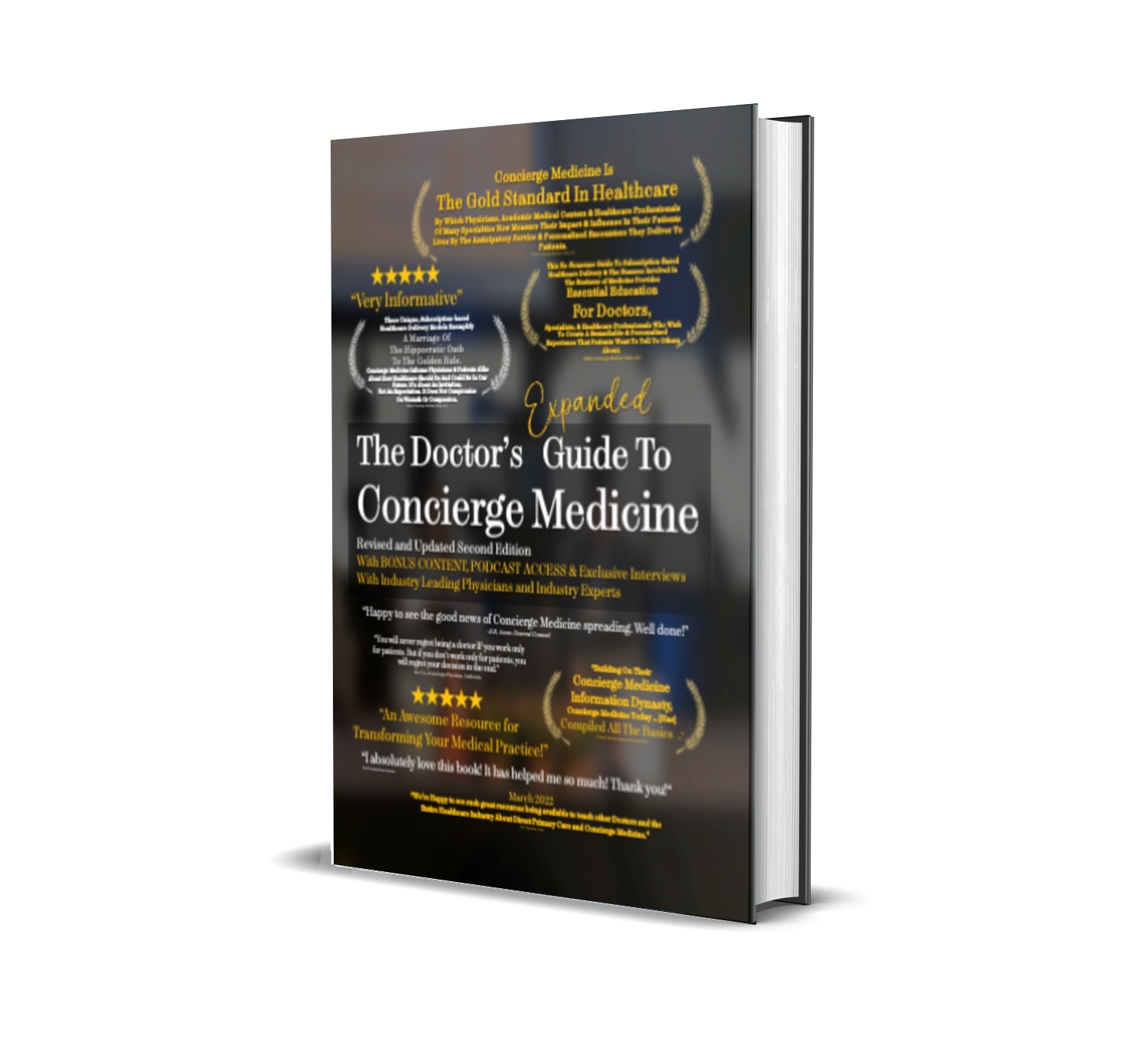
Foundations 102
(Hardcover Edition)
A beginner’s guide to the business, mindset, and core principles that anchor a successful concierge medicine practice.
-

Marketing 201
(Hardcover Edition)
A strategic playbook for growing your practice through authentic marketing, clear messaging, and relationship-centered systems.
-

Experience 202
(Hardcover Edition)
A guide to crafting a patient experience that is intentional, memorable, and worthy of the concierge medicine standard.
-

Referrals 301
(Softcover Edition)
A framework for building a culture of gratitude, referrals, and repeatable moments that make patients feel known and valued.
-

exit 401
(PDF Download)
A structured, FOR-Doctors assessment that helps you plan a thoughtful, well-timed exit from your concierge medicine practice.
A doctor’s guide to concierge medicine
what you’ll learn
For nearly two decades, we’ve seen one consistent theme in this industry: physicians and leaders who want to learn, grow, and lead well often struggle to find trustworthy, practical resources. This is a beginner’s guide to the business, mindset, and core principles that anchor a successful concierge medicine practice. With over 400 pages of industry insights, this resources is meant to help you understand that you’re stepping into meaningful work — work worth doing well. If this book can help you connect with the right information, the right people, or see your next step more clearly, then this educational resource has done its job.
EXCERPTS from
A doctor’s guide to concierge medicine
The Economics of Margin and Meaning
In most industries, productivity is worn like a badge of honor. In medicine, it often becomes a weight we’re praised for carrying. Physicians are celebrated for double-booking, squeezing one more patient into the schedule, or shaving minutes off conversations that used to matter. That kind of applause is hollow. Productivity without purpose isn’t progress — it’s erosion. When a doctor’s value is measured in encounters per day instead of relationships preserved over time, something vital has inverted. Revenue may rise, but resilience quietly collapses.
That’s why the ROI of concierge medicine can’t be measured in dollars alone. The return shows up emotionally, intellectually, relationally. Every minute reclaimed from administrative clutter becomes a minute reinvested in curiosity. Every evening without after-hours charting becomes a quiet dividend of joy. But margin is the guardrail that keeps doctors present, stable, and able to weather cancellations, pandemics, and policy swings. You can’t pour compassion from an empty ledger.
Margin doesn’t appear on its own; it has to be designed with intention. In the calendar, it means blocking time for reflection, reading, or building relationships just as rigorously as you schedule visits. In the contract, it means setting realistic panel sizes and renewal rates — not promising to be “always available,” but committing to be “always attentive.” In your culture, it means training your team that efficiency should serve empathy, not suffocate it. Every system you streamline should buy back a measure of humanity somewhere else.
Before making a transition, many physicians underestimate the hidden cost of chaos: the emotional tax of constant interruption, the financial drag of denials, the cognitive fatigue of endless multitasking. Add them together, and the losses far outweigh the visible profits. Some industry experts operational audits show that physicians who shift from 2,400 patients to around 500 often reduce total work hours by 30 percent — while income stabilizes or even rises. But the biggest gain is qualitative: better sleep, family dinners, laughter returning to the home. In Concierge Medicine Today’s 2024-’25 Industry Annual Report, 87 percent of concierge physicians reported a significant increase in career satisfaction within the first year. That isn’t trivia. That’s testimony.
Margin is not the enemy of medicine. It’s the engine. It’s the difference between practicing medicine as an exhausting obligation and practicing it as a meaningful calling. When the business model supports the mission — instead of smothering it — doctors rediscover the joy that drew them into this work in the first place. And when physicians thrive, patients benefit. That’s the true economics of margin and meaning.
The Systems:
How to Scale Hospitality Without Losing Humanity
In every great experience—whether it’s a memorable hotel stay, a seamless meal, or a truly attentive medical visit—there is something beneath the surface holding everything together: systems. If culture is what people feel, systems are how that feeling happens on purpose. In concierge medicine, physicians sometimes resist systems because they seem cold or rigid. But the truth is the opposite. Systems, when built well, are acts of love disguised as logistics. They remove chaos, reduce guesswork, and free physicians and staff to give patients what matters most: presence, attention, and compassion. A good system isn’t cold—it’s kindness made repeatable.
Think about the way a Four Seasons lobby feels or the way Chick-fil-A makes even a busy lunch rush feel personal. None of that happens by accident. It’s choreography—hospitality engineered without seeming engineered. Concierge medicine can do the same. When your greeting at the front desk, your follow-up workflow, or your annual renewal communication feels intentional, patients interpret that as care. As Horst Schulze often said, “Systems are not there to control people; they are there to free people to do what is right.” In many ways, that’s the heart of unhurried medicine: compassion supported, not suffocated, by structure.
One industry expert we talked to recently describes a concierge practice system as “a series of intentional actions that produce predictable calm.” That calm becomes the bedrock of both patient trust and physician sustainability. Five systems shape the unhurried practice: Communication, Scheduling, Documentation, Follow-Up, and Renewal Workflow. Each can be personalized to fit the practice, but none can be left to chance. Written processes are the difference between consistency and chaos. If it’s not documented, it’s a hope—not a system.
Communication may be the most powerful—and the most dangerous—system of all. It builds trust, but unmanaged, it fuels burnout. The key is defining reasonable availability rather than promising infinite access. One industry legal expert we interviewed recently reminds clinicians that boundary-setting is both a legal safeguard and a wellness strategy. Standard response windows, secure messaging portals, and simple automated confirmations (“We’ve received your message and will respond by…”) reassure patients without draining physicians. Boundaries aren’t barriers—they’re the framework that keeps empathy sustainable.
Ultimately, systems are not about turning medicine into a machine. They’re about creating space for humanity to flourish. When your workflows protect your time, clarify expectations, and remove friction from a patient’s journey, everyone wins. Patients feel cared for, staff feel confident, and physicians feel like themselves again. That’s the real promise of the unhurried model: thoughtful systems that make hospitality scalable without ever losing its heart.
MARKETING YOUR BRAND OF MEMBERSHIP MEDICINE
what you’ll learn
In this book, Michael Tetreault distills more than two decades of frontline work in concierge and membership medicine into practical, eye-opening lessons on marketing, branding, and the patient experience. He challenges physicians to rediscover the heart of medicine by treating every person with dignity and seeing care from the other side of the exam room — the side where trust is earned, not assumed. With clear insight into the expectations of tomorrow’s patients, Tetreault shows why concierge medicine is shaping the future and why the most meaningful practices aren’t just the best in the world, but the best for the world.
EXCERPTS from
MARKETING YOUR BRAND OF MEMBERSHIP MEDICINE
Take a Supporting Role:
Inside the Theater of Your Practice
For years, Concierge Medicine Today has watched a clear pattern emerge: patients aren’t choosing concierge and membership-based models because of cost — they’re choosing them because of trust and convenience. In our long-running survey, 82% of patients said these two factors mattered far more than price. That gap between what patients value and what critics assume says a lot about the modern healthcare disconnect.
Another striking reminder: when CMT asked patients how much they’d care if their traditional practice closed tomorrow, 77% said they wouldn’t miss it at all. That’s not about medical skill — that’s about feeling unseen, unheard, and unknown. Patients aren’t asking for perfection; they’re asking for presence. They’re looking for a doctor and a team who see them as people, not problems in the workflow.
Every patient who walks into your practice has already overcome a string of obstacles just to sit in front of you — traffic, parking, schedules, stress, kids, work, life. Meanwhile, most medical offices are running the daily “function-first” playbook. Staff focus on tasks, not scenes. Patients, however, experience their visit as a story — a sequence of small moments that either build trust or chip away at it.
That’s why the best practices in concierge and membership-driven models flip the script: the patient becomes the hero, and every clinician and staff member plays the supporting role. When you shift from “How do we get through the day?” to “How do we remove friction for this patient, right now?” you create memorable moments that people talk about long after they leave. In that instant, you become their ally — not another obstacle.
Because here’s the truth: hospitality in healthcare is a process, but the patient should never feel processed. Your practice is a stage, your team is the cast, and the story your patients tell afterward becomes your brand. Every scene is an opportunity to surprise and delight, to lower a barrier, or to offer a moment of calm. And in a world where most patients aren’t expecting that at all, your willingness to take a supporting role may be the most remarkable thing about your practice.
Unnecessary Brand Confusion:
Why Healthcare Trips Over Its Own Words
There’s a well-known leadership truth: “If there’s confusion in the marketplace, there’s confusion in the office space.”Healthcare is no exception. In fact, we might be the worst offenders. Like politicians, we have a longstanding habit of making things complicated — sometimes for good reasons, sometimes because of “that one patient, that one time.” And now, after decades of growth, the membership-medicine space has a new challenge: terminology tension. The industry has matured faster than its vocabulary, and the result is a growing gap between what insiders mean and what patients actually understand.
This isn’t a new problem — it’s classic “insideritis.” We start talking to ourselves, not the people we serve. Leadership voices like Carey Nieuwhof have warned about this for years: insiders know the language, but newcomers are lost. You see it everywhere in healthcare. Patients don’t know our acronyms. They don’t speak our shorthand. They don’t live in our world. And when the language becomes murky, trust becomes harder to build. Even simple words like “bespoke”or “concierge” have shifted in meaning over the years, gaining glossy marketing spins that make them sound like luxury products rather than care models focused on access, time, and relationship.
The confusion only deepens when similar-looking terms collide. “Virtual primary care” gets mistaken for direct primary care. VPC becomes D2C telehealth in a single article. Meanwhile, “evidence-based medicine” sounds brand-new to some people — when it’s been around since the early 1990s and rooted in solid, thoughtful clinical decision-making. And in the subscription/digital health boom, even models with good intentions have added more labels, more buzzwords, and more noise to an already noisy marketplace.
Here’s the irony: while healthcare wrestles with vocabulary, patients are busy choosing clarity over complexity. Cash-pay, retail, and membership-based practices continue to grow because they make the experience simpler, more predictable, and more personal. As Medical Economics noted, predictable monthly costs remove barriers. As Kyna Fong argues, process-heavy systems actually take away the tools physicians need — causing frustration on both sides. The membership-based world hasn’t just changed healthcare delivery; it has rebuilt the patient-provider relationship by reducing friction and restoring dignity.
So if all of this language has your head spinning, you’re not alone. The subscription-based movement in healthcare has gone through several generations — from early cash-pay models in the 1900s, to bespoke concierge care in the 1990s, to today’s contemporary membership-driven Personal Care Models. Each wave built on the one before it, each adding new ideas and (unfortunately) new terminology. But here’s the good news: beneath all the jargon lives a simple truth — patients want clarity, belonging, trust, and care that feels human. And when you strip away the labels, that’s exactly what these models are trying to offer.
Disclaimer: Personal opinion. Not medical, legal, or financial advice. Please do your own due diligence.

“This new practice has been truly liberating. I am working harder than ever getting it of the ground but my time with patients is wonderful. And I get to be creative again in how I develop the practice, something that was lost from my previous office.”
— Dr. C., Vermont
Dan Carlin, M.D., founder of World Clinic, a telehealth-intensive national concierge service, believes that while “the total number of Medicare opt-outs may remain small, the demand for personalized, membership-based health care continues to rise, creating expansion opportunities for concierge models without requiring a large-scale shift in Medicare participation.”[Credit] … Also, whether the patients are millionaires getting “executive physicals” in high-end private practices or employees getting extra services on top of their E/M visits, Carlin says “this trend is less about Medicare opt-out rates and more about the increasing patient demand for high-touch, accessible care — an area where the concierge medicine model continues to thrive.”[Credit]
"My real joy is spending time with patients and trying to help them improve their health. In many practices, the high volume of patients that must be seen reduces the time clinicians can spend with each patient. Our model increases the time available for each patient encounter. I spend about 30 minutes with a patient during our average visit. This is the main reason that most patients give for returning to our practice. People are willing to spend money on something they value, and they value time with the doctor."
— Dr. F., North Carolina
“You will never regret being a doctor IF you work only for patients. But if you don’t work only for patients, you will regret your decision in the end.”
— Dr. L, California, Concierge Medicine Physician
“My focus is on being a trusted advisor and I don't want to have any potential conflict of interests ... For example, a lot of doctors make money on supplements, for me I take that out of the equation. In terms of my practice, I just want to focus on providing the best advice I can give my patients, not worrying about making money off retail.”
— Dr. M, Concierge Physician, CA
"We’ve always believed in being a patient’s ‘healthcare quarterback,’ so we negotiated highly competitive rates for lab and imaging services within our market. We determined the services most crucial to our patients, educated ourselves about available resources in our community, and created a list of options with full cost transparency."
— Dr. F., & Dr. T., Colorado
"The conversion process is not an easy one, my staff and I are cognizant of the fact that we must consistently communicate the benefits of this choice in care, with the challenge to increase my [memberships] numbers and convert other patients."
— Dr. G., Concierge Medicine Physician in Florida
“Direct practices should be successful in most cities and states where there is an inadequate supply of primary care physicians. This may be true in the country with the correct practice model. Most important, a physician needs to have social skills to sell him/herself and there new practice model to their patients and their community.”
— Dr. E., Texas
“Some have said, ‘We’re in the Golden Age of technology but Dark Ages of delivery.’ We have resources but no time to utilize them to their highest & best use.”
— Dr. K, concierge medicine physician, Medical Director, Quote from interview, Medical Economics
"Direct Primary Care (DPC) is not insurance, does not strive to replace health insurance, nor is it adversarial to it. On the contrary, many DPC practices are eager to work with insurance carriers to co-create blended plans which integrate DPC with high-deductible insurance and ultimately correct the perverse incentives which are rife in the traditional fee-for-service system."
— Dr. T., Colorado
"I received a phone call the other day from a physician in Winter Park Florida. She was calling just to thank me for answering her questions about [this industry] a few months ago, and encouraging her to start her own practice. Today, her practice is thriving and she said that 'she is happy with her schedule, her life, and being able to practice medicine that way it is meant to be practiced.' I was so happy to hear that I helped a fellow physician and colleague, and even more happy to hear that she was doing so well!"
— Dr. D., D.O. a concierge medicine physician in South Florida
"In the next 10 years, people are going to want: 1: Be diagnosed and treated within minutes, not days or weeks. 2: Ongoing relationships throughout a health issue. 3: At a price that seems reasonable to them."
— Dr. Jay Parkinson, Sherpaa @jayparkinson; January 2018
“The concierge model is a great option for physicians seeking more control over their time, their professional lives, and their ability to care for patients. But it is by no means a financial cure-all. My life is so much better now. It’s a big improvement. I’m enjoying the benefit of more time for my family and my kids, more time to do administrative stuff during the workday rather than after-hours. But it’s not like my financial woes suddenly disappeared, especially during the first year.”
— D., MD, family physician in Mission Vejo, CA
"While it is true, as the AP reported, that more and more patients are joining our practices nationwide, the number of patients is not just in the thousands already but in the millions. While it is true that concierge practice is exponentially on the rise, the current number of such doctors is not just in the hundreds but in the thousands, perhaps tens of thousands. Most are below the radar. They work quietly and are never counted by bureaucrats."
— Dr. L., Concierge Medicine Physician, California
“There is no substitute for a doctor who one knows and trusts, and who acts exclusively on behalf of one's own needs and interests. Fortunately, many people can have this type of care. For people who are enrolled in high deductible insurance plans, they can apply their annual retainer fee toward their deductible. For people who have flexible spending accounts, they can use the money from that account toward the annual retainer fee. My fee is less than the cost of a daily sandwich lunch or a monthly cable contract. I think if more of the public were aware of how affordable this care can be, more people would be clamoring for it. Access 24/7, prompt appointments, same or next day sick visits, unhurried visits, health care coaching, continuity and advocacy. What is there not to recommend this model of care?”
— Dr. F., Concierge Medicine Physician, Baltimore, MD
“My vision is to cultivate a personal Patient – doctor relationship amidst a bustling urban community where impersonal professional relationships are the norm. Our practice strives to deliver quality medical care with an emphasis on evidence based medicine, open communication, easy accessibility, and a focus on customer service. These benefits can lead to an overall improvement in how healthcare is delivered and may ultimately improve outcomes.”
— Dr. E., Atlanta, GA, Concierge Medicine Physician
“This is healthcare the way it should be, with zero compromises. It’s about being cared for in the way you would care for your own family member.”
— Dr. M, Concierge Medicine Physician
"I am amazed we have received so much recognition that within a few years an entire field of “concierge” practices emerged nationally. Our Practice was designed around this ideology: provide the convenience, accommodation, and best-of-class service you expect from every service provider in your life. The very nature of these relationships necessitates we limit our practice to so few."
— Dr. M, Concierge Medicine Physician
“If you possess excellent communication skills, around the clock dedication and the desire to promote optimal health in pursuit of excellent medicine, then concierge medicine is for you. It’s the best career choice I’ve ever made.”
— Dr., T., Pediatric Concierge Medicine Physician
“Instead of viewing the status quo PCP model as the center of the universe. Maybe we should take some plays from the Retail Clinic playbook before we become obsolete.”
— Dr. N., GA (Retired) DPC Physician
“We try to make it fit into your lifestyle instead of disrupt it. You call the office, you call my cellphone, you text me, email me and we set something up.”
— Iowa; Concierge Medicine Physician, Dr. I.
"Our phone trees, answering services, and after hours call-sharing doctors make it unlikely that any given patient will actually speak to their own doctor. So they don't bother, and they seek care wherever it is most convenient."
— Dr. C., GA, Concierge Medicine Physician
"To those who say concierge doctors are hurting the system by diminishing the number of patients we can care for, my reply is: if you keep doing the same thing year after year, you are going to get the same results! If we don’t focus on salvaging the doctor-patient relationship and allowing the appropriate time for each patient’s care and follow-up, patients will begin to feel their primary care is a waste of time."
— Dr. B, Omaha (NE), Concierge Medicine Physician
"Care is about access and communication, not doing stuff necessarily. I am not sure if there is any way to change this, but it seems that any visits my patients have (or communication with me) is something they get in exchange for my monthly fee."
— Dr. L., GA, DPC Physician
"There was a time when patients valued their family doctor, trusted our opinion and called us after hours to help decide if symptoms needed urgent attention or could wait."
— Dr. C, GA, Concierge Medicine Physician
"What I found interesting was that when I left my old practice -- I had a 10% Medicare population. That fraction has grown to almost half, suggesting to me that some of the folks most interested in this model are older patients."
— Dr. F., Concierge Medicine Physician
"Patients were skeptical and reluctant because of how accessible and convenient the service was. They expected to be kept waiting on hold. Some seemed puzzled by the fact that when they called I answered the phone and knew who they were. One patient even inquired as to how come they only had one form to fill out. Direct-access primary care patients who have been referred post hospital discharge, have not been readmitted to the hospital in the last 4 years because I can see them without delay or red tape. In NYC, despite the high number of physicians per patient, particularly on the upper east side of Manhattan, direct-access primary care can still be a viable practice solution for patients and providers. It helps patients cut through the red tape that has become expected in accessing health care.”
— R.Z., Nurse Practitioner, NY, NY
“The road was much more difficult than I expected, but also much more satisfying. I spent much of my time learning what doesn't work, but in the end learned that most good ideas grow out of the remains of a hundred bad ones that didn't survive.”
— Dr. L., Augusta, GA, DPC Physician
"We recognized back in 2000 that health care was moving from personal to a more institutionalized form, and it wasn't what we wanted to do. "We felt we needed to have time with our patients, to have the excellence to have the time with patients. Health care has been cutting reimbursement to doctors, which has forced doctors to see more patients, so the time doctors have with their patients have declined. The average time today with patients for most doctors is only 10 minutes."
— Dr. B., Concierge Medicine Physician, Michigan
"It took me over 16 years of practicing medicine to finally realize the significance of this timeless painting. At the time, this painting was viewed as iconic due to the public’s desire to be cared for with a single-minded attentiveness. It brought the focus back to the doctor patient relationship. Simply put, it is about the physician being there for his patient. Letting this patient know they are not alone. Sometimes that is all we have to give, but it can be exactly what is needed."
— Dr. L., Concierge Medicine Physician
“There are no insurance codes for ‘cure.’”
— Dr. B., DPC Physician (Retired), Washington
“Young doctors are refusing to go into primary care medicine. This is due to the fact that practicing primary care medicine in our current broken system, seeing 30 patients per day, making only one-third to one-fourth of what a specialist makes, have created an understandable shortage of doctors willing to practice primary care medicine. Over the long run, the only way to increase the number of qualified primary care doctors is to make the profession more attractive, both from a professional and financial perspective. It is our current broken system that has caused a shortage of primary care doctors; and if we stay on the old path, it will only get worse.”
— Dr. K, Concierge Medicine Physician, Arizona
“The genetic revolution has already begun, and it is having far-reaching effects on healthcare right now. Our knowledge of how to use this information is increasing at an exponential rate. What this means is that we can now start to integrate genetics into our everyday lives. With comprehensive genetic testing, we launch an innovative strategy against disease, attacking it before it even manifests. Genetic testing, therefore, provides a new counter-offensive in our war against Alzheimer’s, cancer, heart disease, and many other diseases that have plagued our civilization for centuries. This is the most exciting, and potentially groundbreaking, medical development of this century.”
— Dr. C., Keynote Speaker, 2017 Concierge Medicine Forum, the industry’s annual conference organized by Concierge Medicine Today
"The past year has been one of big changes. We are continuing to grow the practice in numbers, but we are also working to improve our quality. There's a lot to be done still! We added immunizations. At the present time we are doing adult immunizations, but are soon to move fully into pediatric immunizations. We continue to work on improving our quality, collecting information and reaching out to people who are needing care. Our goal is to continue to improve the quality of care from where we are now."
— DPC Physician, Georgia
“I had to do this to be able to do my job, I get to practice the way I think I can practice best. It’s capitalism at its best.”
— Dr. Z, (Deceased), Concierge Medicine Internist, Since 1987
"Patients value speed and low cost most of all for most minor complaints. Even my patients who pay a membership fee for all of their covered and non-covered services including 24-hour access to my personal email and cell phone number, and whose care for these complaints would be covered without additional cost, still use these [retail medicine style] health providers [i.e. CVS, MinuteClinic, TakeCare Clinic, etc.]. Many patients say, 'I just did not want to bother you on the weekend, and I was near there anyhow.' As long as we live in a world of drive-though windows, ATMs, and garage door openers, patients are going to value and pay for any service that gets them in and out quickly, on their time schedule, with their desired objective. We [Concierge Medicine and Direct-Pay Doctors] need to learn to adapt, as this delivery model of care seems here to stay. Unless we offer on site dispensaries, extended hours, and no appointment needed delivery, we will be deferring more urgent issues to these models. Perhaps then we will have more time to devote to preventing disease and reversing the burden of chronic conditions, if only we can convince third party payors that there is value in that."
— Dr. C, Concierge Medicine Physician, GA
“I believe that is the way medical care is supposed to be. This kind of unfettered direct engagement between doctor and Patient can never be achieved in a system of third-party networks where the doctor is a “provider” of services paid by someone else and the Patient is relegated to a passive ‘network subscriber’. Primary Care needs to become relevant again by servicing patients directly and being available and offering the kinds of broad services that family doctors used to offer. Only returning to broad-based primary care that is affordable (DPC and similar), getting back in the hospitals and being available to keep our patients out of the ER and urgent care will solve this supply-demand imbalance. This kind of approach will also drive more medical students back into primary care and restore the balance back to the ratios before managed care."
— (Retired) DPC Physician, Dr., N., of Atlanta, GA
"Not all direct primary care practices are concierge practices, and not all concierge practices are direct primary care practices. The terms are not synonymous, and even the basic fundamentals of either model do not overlap. The key to differentiation is whether or not a third party payer is involved. If not, then the model is a direct pay, or direct primary care model, no matter what the fees."
— Dr. Q., (Former) DPC Physician; Entrepreneur, Inventor
“I didn’t become a doctor to bankrupt my patients …”
— Dr. G., DPC Physician
"After being told repeatedly by video doctors that they can’t diagnose or treat what you’ve got and you’ve got to see a doctor in person, after you’ve spent $79, you’re probably just going to hedge your bets next time and instead go to the local urgent care center and blow $300."
— Dr. P., January 2018
“I’m 60 years old now and I had to figure out how I could continue to practice medicine, enjoy it and enjoy my life at the same time. This is something I decided to try and see if it works, and so far, it’s working.”
— Dr. A., Georgia
"Being a good physician is not just about knowing how to diagnose and treat disease. Honestly...that's what books and studying is for. Being a good doctor entails earning the trust of your patients by being honest and forthcoming. It means knowing how to communicate effectively while still remaining sympathetic. It requires you, first and foremost, to be a human being. It honestly bothers me that young doctors feel like they have to "know everything" to be a great physician. Put down the damn book and go talk to your patient. Be a friggin human being. Be a friend. Its really that simple."
— Dr. D., Concierge Medicine Physician, South Florida
"Preventative medicine is now our top priority. The upfront costs associated with genetic testing, inflammatory testing, etc. pales in comparison to the cost of treating chronic disease. Stakeholders are realizing that it is more important to invest in technologies that detect disease at an earlier stage when it is less challenging to treat effectively. Spending capital now on tailored treatment plans for individuals will save billions in the future."
— Dr. P., Texas, Concierge Medicine Doctor
“My focus is on being a trusted advisor and I don't want to have any potential conflict of interests. For example, a lot of doctors make money on supplements, for me I take that out of the equation. In terms of my practice, I just want to focus on providing the best advice I can give my patients, not worrying about making money off retail.”
— Dr. M., Concierge Medicine Physician, Calif.
"Since 2005, I have been providing comprehensive primary care to families and individuals of all ages in San Francisco. Through mutual respect, careful listening, and collaborative communication, I have built strong long-term relationships with patients and health care providers in the community."
— Dr. B., Concierge Medicine Physician, CA
“You will never regret being a doctor IF you work only for patients. But if you don’t work only for patients, you will regret your decision in the end.”
— Dr. T.L., Concierge Medicine Physician, CA
“I had to do this to be able to do my job. I get to practice the way I think I can practice best. It’s capitalism at its best.”
— Dr. M.Z., California, Concierge Medicine Physician
“I really have time to think about my patients when they’re not in front of me,” said Dr. Greene, a pediatrician who joined the company’s Los Angeles practice in October. “I may spend a morning researching and emailing specialists for one patient. Before, I had to see 10 patients in a morning, and could never spend that kind of time on one case.”
— New York Times; June 3, 2017
"Business is tough. If you are doing something just for the money, you are never going to enjoy it. You will be the hardest boss you have ever had. So, find something you love and pursue it. Follow this advice and you will set yourself up for an enjoyable future in medicine.”
— Dr. E., Texas, DPC Physician
"The art of medicine is the application of all this information and skills we learn and relaying this in a humane way to this one patient in front of you. Which is the only thing that matters at this moment. I am here for you is what each patient deserves to feel. This in my opinion is what separates the good doctor from the great doctor. That skill is innate. Those going into the field for the right reasons have this within them."
— Dr. L., Concierge Doctor, California
“The heart of good medicine is care. I think the key to concierge medicine is the personal relationship between doctor and patient.”
— said Dr. P., a concierge doctor, PA
"To those who say concierge doctors are hurting the system by diminishing the number of patients we can care for, my reply is: if you keep doing the same thing year after year, you are going to get the same results! If we don’t focus on salvaging the doctor-patient relationship and allowing the appropriate time for each patient’s care and follow-up, patients will begin to feel their primary care is a waste of time."
— Dr. B., Concierge Medicine Physician, NE
“We all say we should get the same care, but I got sick and tired of waiting for that to happen,” he added. “I decided to go for quality, not quantity.”
— New York Times; June 3, 2017
“In selecting only a small population of clients and providing dedicated counseling sessions, sometimes as often as weekly, allows clients to actively participate in their care plan and to move goals forward at a real-time pace. This enables all of us to realize that healthcare can be a positive experience.”
— Dr. B., Concierge Medicine Physician; Entrepreneur; AZ
“Slow and steady growth is ideal in this type of practice because it allows you to offer patients a personalized experience. I’ve found that the word-of-mouth aspect (vs. a billboard advertising approach) has been the most consistent factor in building my practice. I consistently have patients recommending their family members and friends. Getting word of mouth referrals based on high quality care, staff service and patient satisfaction has been a much more effective tool than traditional marketing. And the slow and steady approach ensures that staff can keep up with new patients, as opposed to getting a rush of new caseloads that would be more difficult to manage all at once.”
— Dr. B., Midwest, Concierge Medicine Physician
“It’s a different type of busy … My day is just as long now, if not longer. But, I’m spending a lot more time with all of my patients. In between visits, I’m on the phone checking on people at home.”
— Concierge Medicine Physician in FL
"Instead of just looking at blood, I’m looking at blood, urine, stool and saliva. Instead of just chemistry markers, I’m looking at chemistry, metabolomics (chemical fingerprints of cellular processes), genomics, microbiome (microorganisms), hormone tests, and I’m starting to look at immunology markers. That’s a very different experience. In a perfect world, your body is like the airplane and I’m the co-pilot and we’re using all these tools to identify if there are issues going wrong with the engine."
— Dr. M., Concierge Medicine Physician and entrepreneur, California
“Running on the discount-insurance based hamster wheel is fatally destructive to doctor morale, patient care and the entire health system.”
— Dr. L., Concierge Medicine Physician, California
"My overhead is a phone, an electronic medical record, internet access, rent for office space and one medical assistant. The clinic is built lean because we don’t have to deal with the insurance companies. The revenue that is generated through the monthly fee of $39 to $89 per month is where we get the money to pay our overhead and the doctor’s salary. We don’t need to make a profit on anything else."
— Dr. L., Concierge Medicine Practice, Family Physician
"I made the switch many years ago into concierge medicine, or at least a form of it, and I couldn't be happier. I can provide better care and build a strong relationship with my patients. It definitely can be challenging since I make myself available 24/7, however if you can develop a good support structure of other like-minded MDs you can maintain a successful business with less stress than a traditional practice."
— Las Vegas Urgent Care Doctor

Expert Guidance Series
A collection of expert conversations, perspectives, and informational resources from Concierge Medicine Today that helps clinicians better understand the business, regulatory, and operational landscape of concierge medicine. (Watch and Listen Below)
“A Doctor’s life moves to a better place when they move at a sustainable pace. I think sometimes there is still skepticism about ‘What is concierge medicine?’ and ‘Hey, what’s the bottom line?’ But I believe we’re starting to see evidence that if Doctor’s don’t do something like this, it will impact the Physician, the Patient, our communities and the bottom line in a negative way. And so that’s one of the things that we’re addressing in this marketing book FOR Doctors. How do you create a remarkable patient experience worth remarking about to others? Hospitality in healthcare, sure, it’s a process but patients today shouldn’t feel processed. Like you, I simply want to leave our healthcare culture in a better place than how it found me and my kids years ago.”
— Editor-in-Chief, Concierge Medicine Today, October 2025
updated new series for 2026
Disclaimer: Personal opinions. Not medical, legal, or financial advice. Please do your own due diligence.
🎙️Cash Healthcare: How Does It Really Work??? Industry Legal Expert 🎙️ Weighs In!
Today our guest is an attorney and an old friend! You probably know him, Jim Eischen, Esq. He’s a talented musician, a motorcycle rider … and more importantly FOR Doctors today, Jim’s an expert in cash healthcare and compliance.
Legal Considerations 🎙️ Concierge Medicine is Creating a Splash from the Windy City 💨 to the Sunshine ☀️😎 State: But Remember, It’s Not a One-Size-Fits-All Solution!
Jonna D. Eimer is a health law and corporate attorney and shareholder at Roetzel & Andress in Chicago, Illinois. She represents numerous concierge medicine practices and has extensive experience with other innovative practice models. She also advises her clients – including physicians and physician groups, dentists, behavioral health clinicians, and other health care providers – in forming new practices, selling established practices, and negotiating employment and shareholder agreements, as well as guiding them with respect to regulatory matters.
Why Are There So Many Concierge Medicine Practice Transactions?
Most physician owners of concierge medicine practices do not have experience going through a practice sale or major partnership transaction — here are some helpful and practical recommendations to consider.
FOURTH OIG ALERT: RPM and CASH HEALTHCARE IN AMERICA — 2025-2026 IMPACT ON MEDICAL OFFICES
Jim Eischen, Esq. is recognized nationally for compliance experience regarding complex corporate business planning and transactions. As a speaker at conferences throughout the US, he addresses data privacy, regulatory business planning problem-solving, and start-up innovation monetization.

HISTORY AND TRENDS
A clear look at concierge medicine’s origins and the trends shaping its future. (Read More)



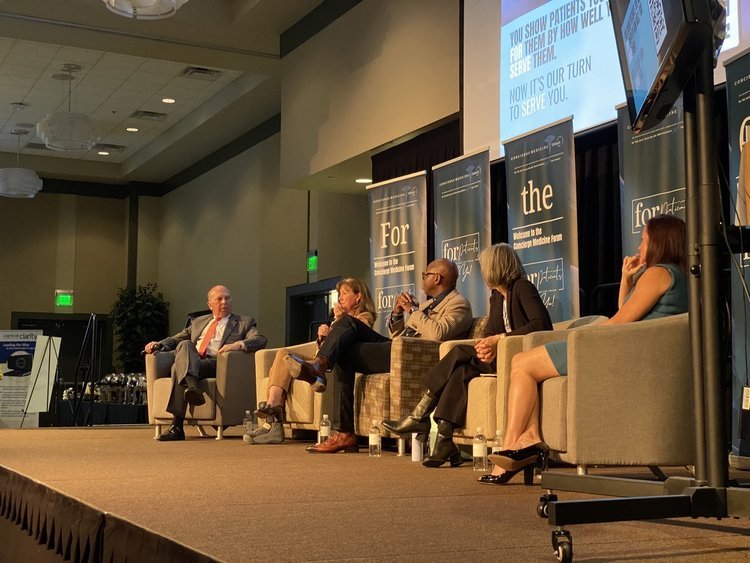
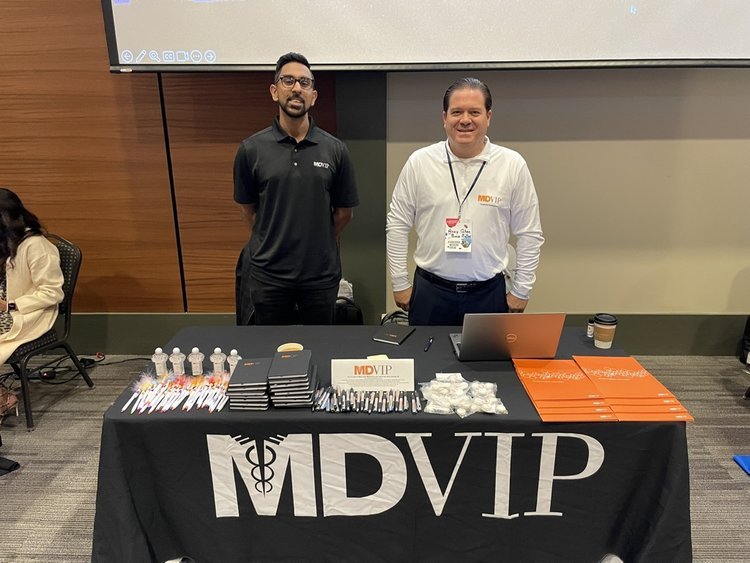




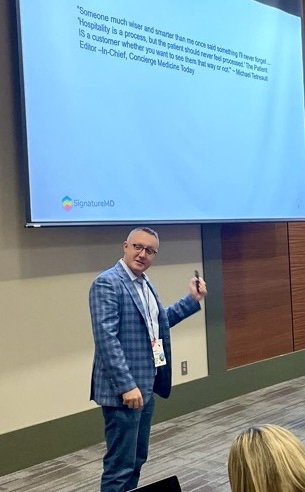
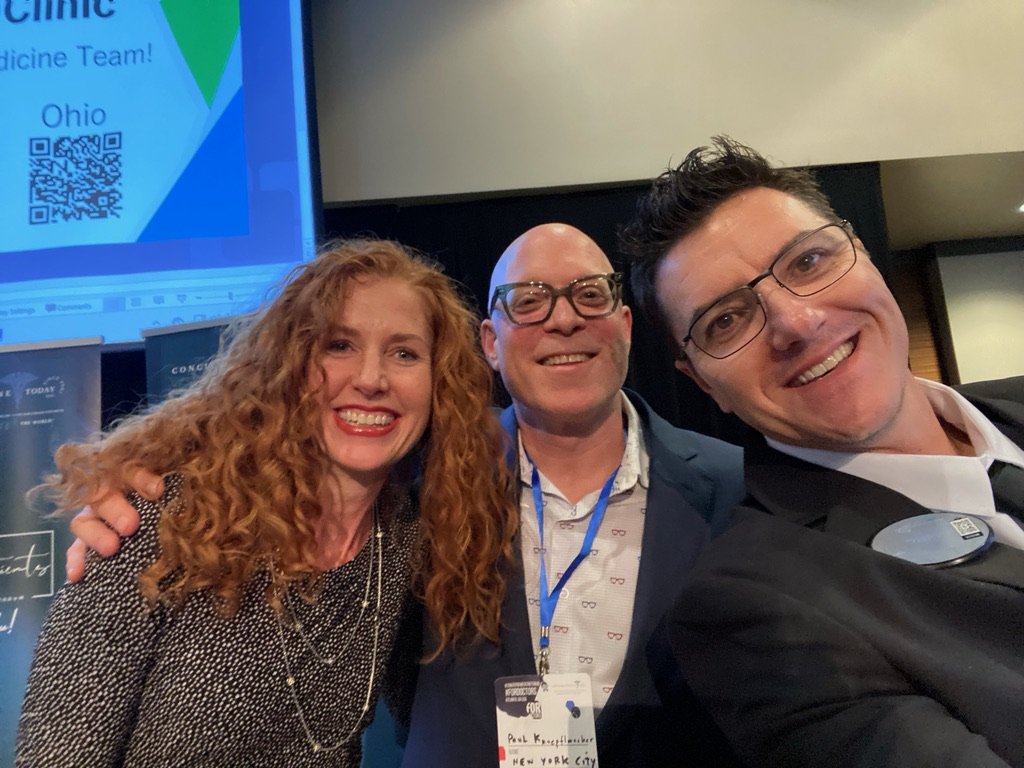
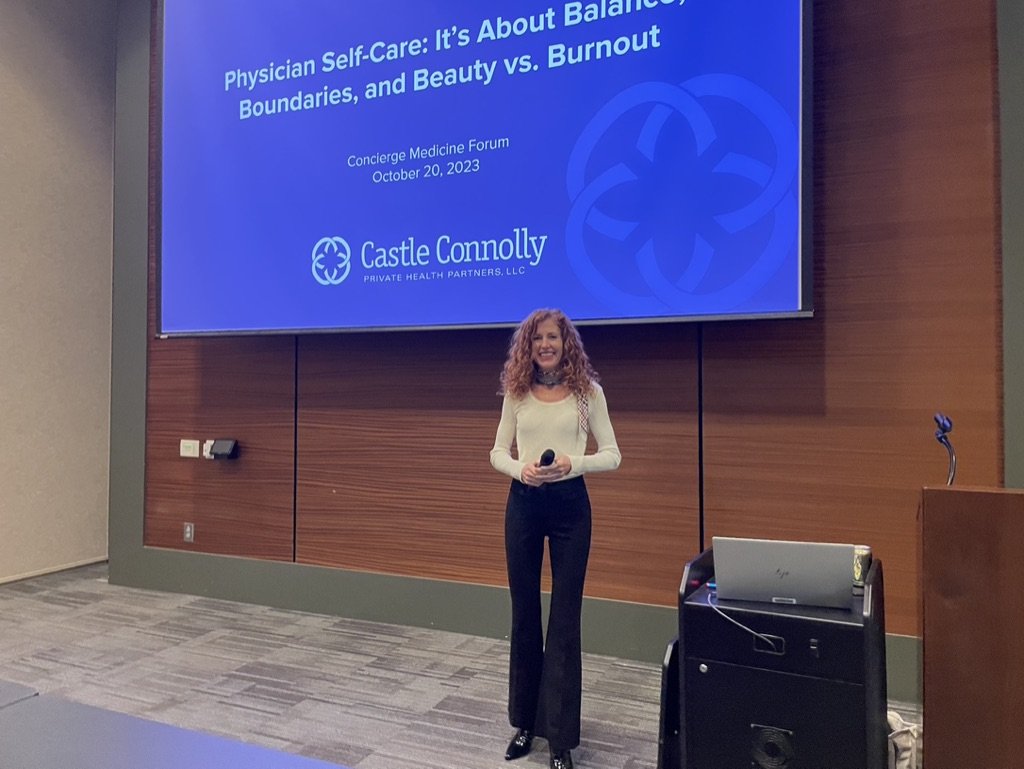






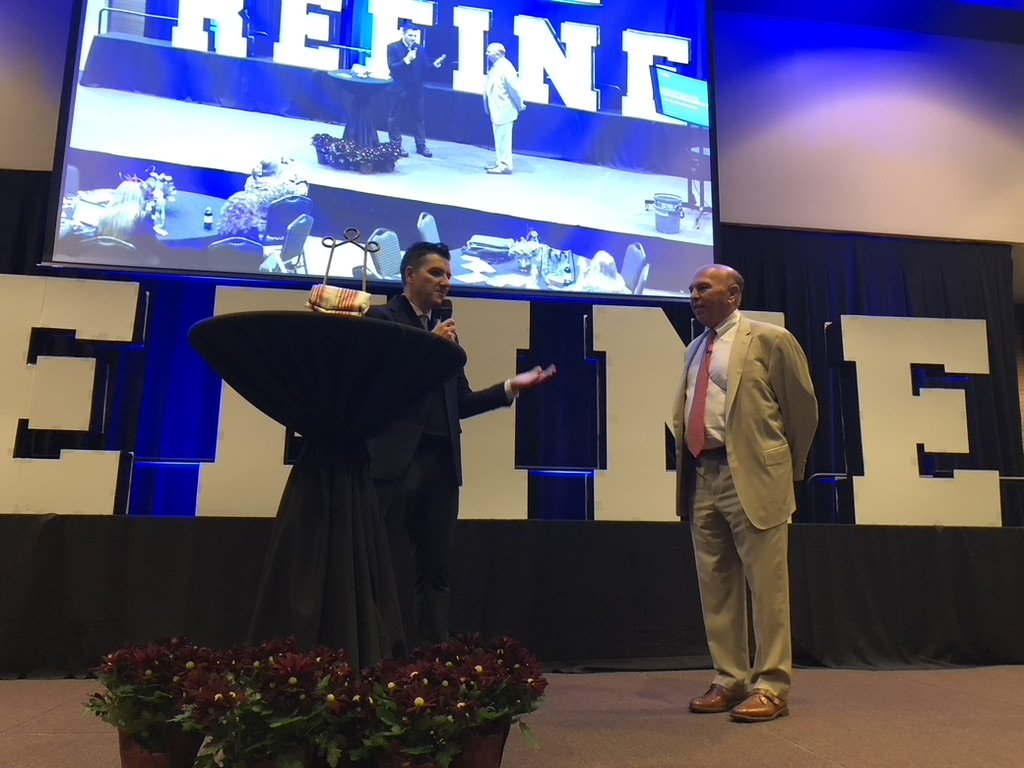

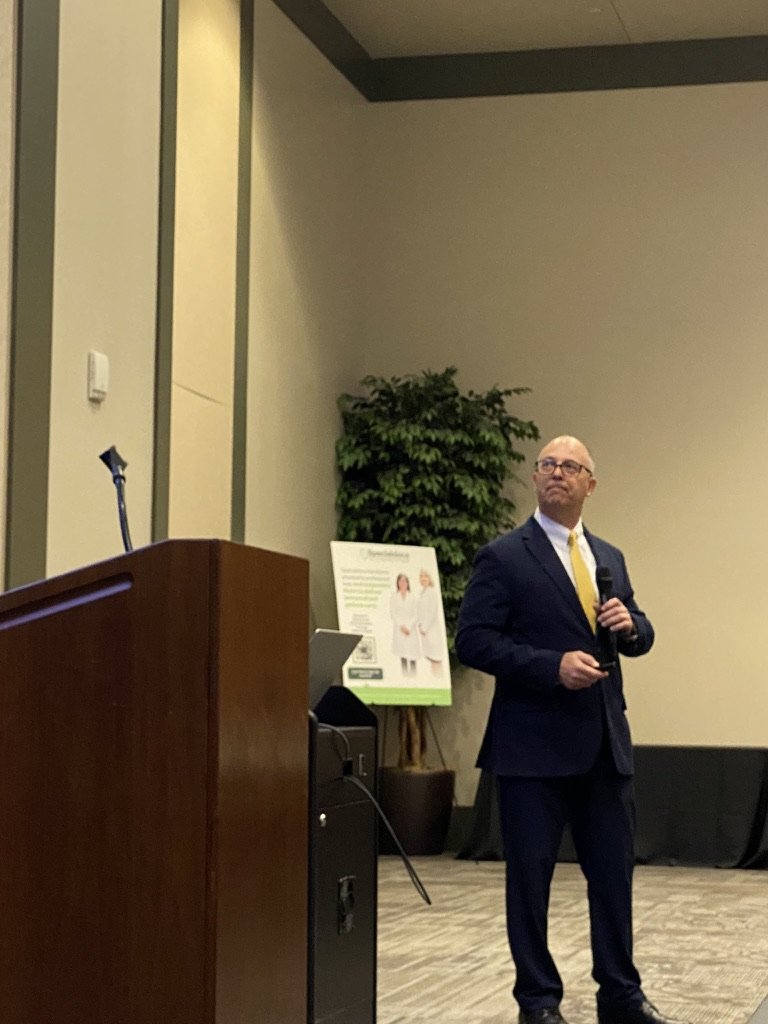
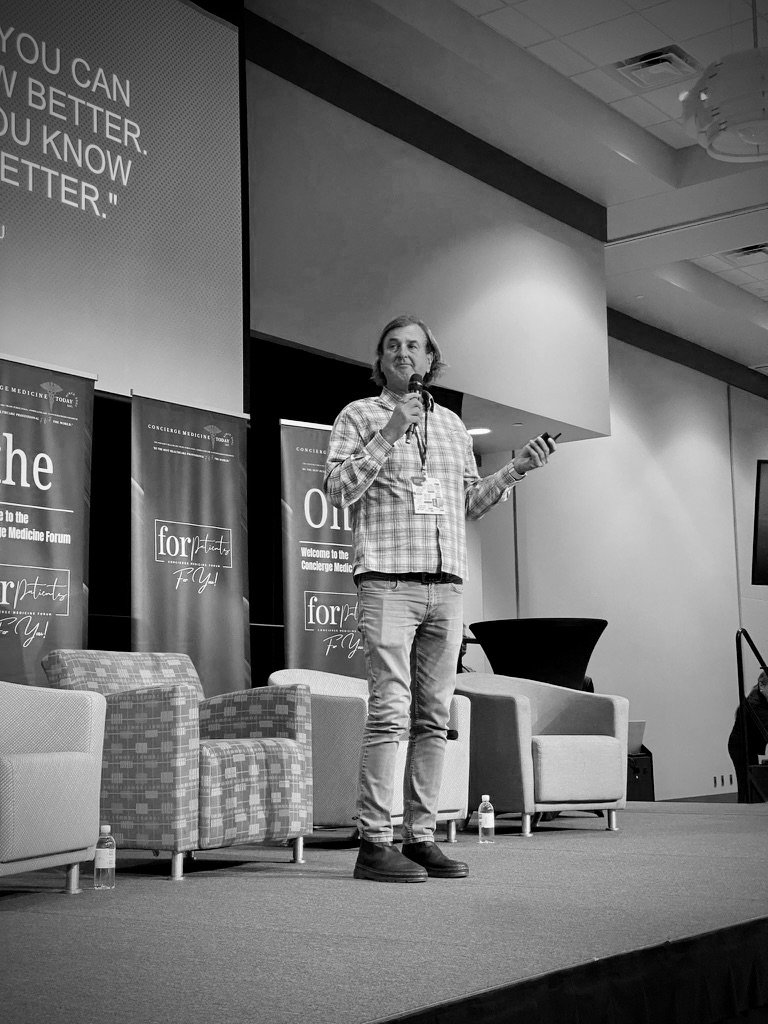
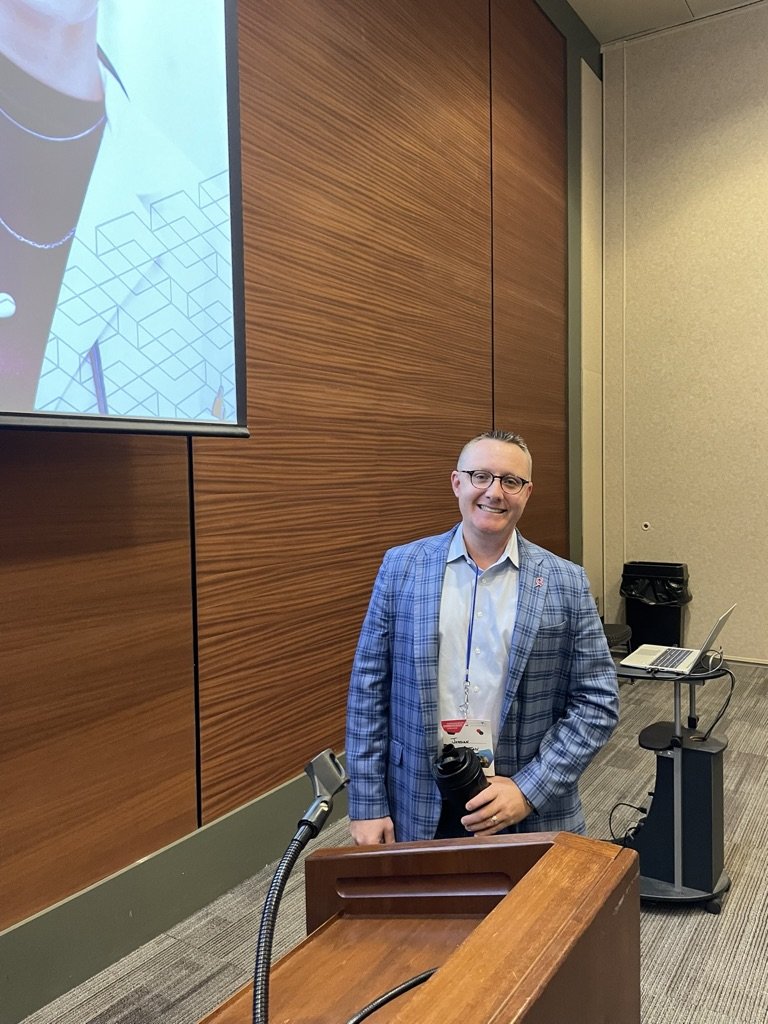

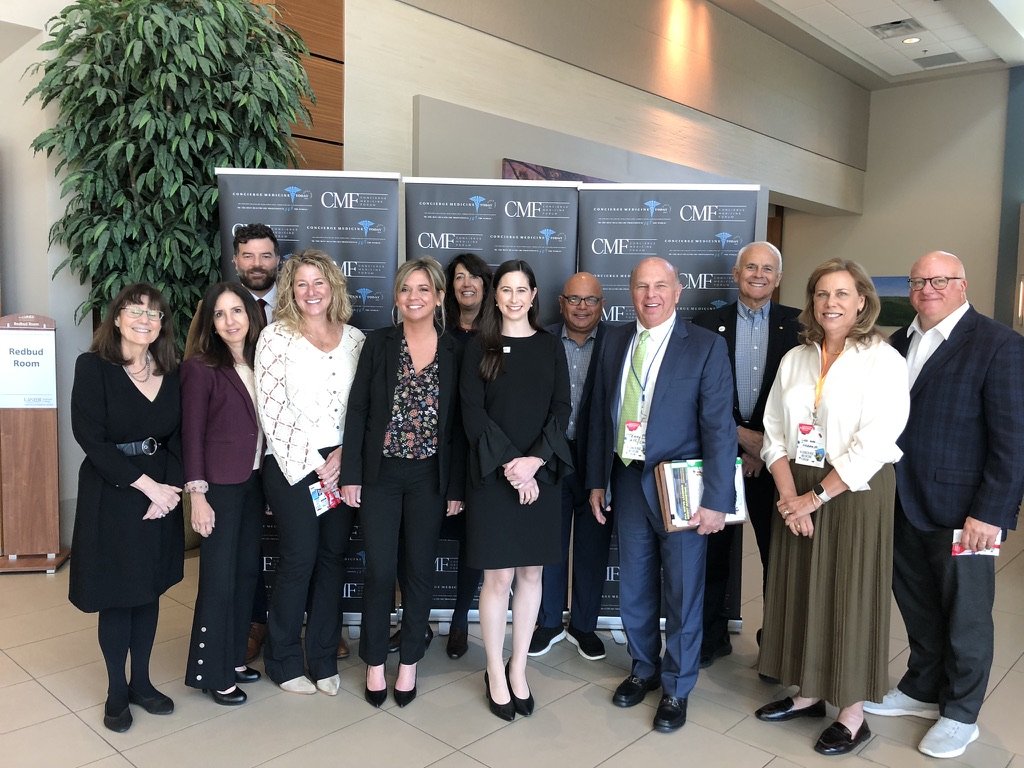




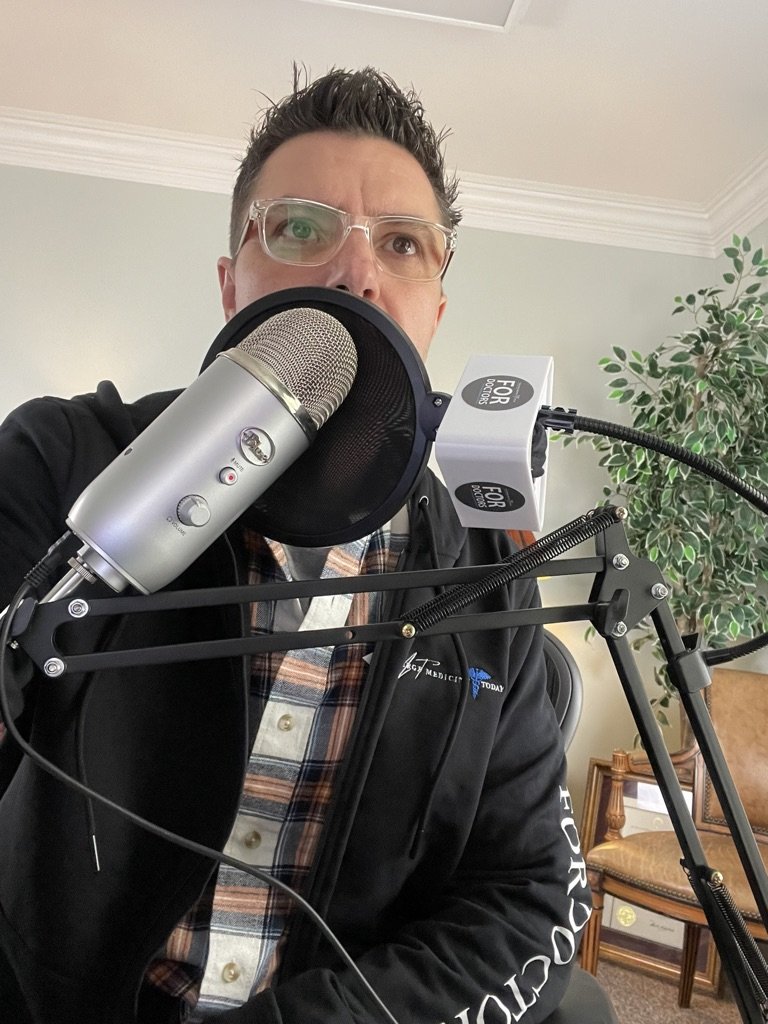
1900’s
CASH-PAY HEALTHCARE
First Generation Iteration: Some experts trace the roots of this cash-pay healthcare model way back to 1913, with the focus on regular check-ups to keep sickness at bay and where a Doctor would carry a medical bag right into our home. This model however, has probably been cruising around for nearly a hundred years (or more), safeguarded by three federal statutes and a heap of Medicare/OIG guidance that many haven't even heard of.
The root of US cash healthcare was routine exam care, exams/communications detached from medical necessity and delivered on an ongoing basis regardless of condition. The concept can be found in a 1913 US medical practice that touted this as superior prevention/care (it was, still is). In 1920/1921, the same concept was envisioned as a US worker health solution, to increase productivity and better protect employees (Eischen; 2025).
1990’s
ENTER BESPOKE CARE
Second Generation Iteration (Bespoke Concierge Medicine): Bespoke or luxury concierge medicine birthed out of cash-only healthcare in the 1990’s. MD2 was key in starting concierge care by creating a new type of primary care that focuses on personal attention and easy access to doctors. Founded in 1996 by Dr. Geoffrey C. Friesen and Dr. John C. M. R. C. "Chuck" B. Friesen, MD2 offered a way for patients to get more time with their doctors and a variety of services for a yearly fee. This model changed how patients interact with healthcare, allowing them to receive better service and quicker care. It significantly influenced the growth of concierge medicine in today's healthcare system (Avery, A. & Barlow, J.; 2017).
In summary, and according to industry experts and sources over the years, in 1999, the term "concierge" emerged to define a cash healthcare model akin to the executive health model, with added claims of improved time and care coordination, etc — but it was still the same old model under the hood and more or less earned a thumbs-up from HHS in 2002 via public letters (Eischen; 2025).
ACROSS THE POND
For more context and additional information and education about concierge medicine and private practice services in the U.K., please see below.
The U.K.’s concierge medicine market has evolved from niche private GP care to a diversified sector with digital hybrids, corporate packages, and luxury health programs.
🕰 Historical Timeline — Concierge Medicine in the U.K.
(For reference and General Information Only - please see disclaimers)
Pre-2000s – Private GP Practices Exist but “Concierge” Term Rare
Private general practice existed for decades, mainly serving executives, diplomats, and private health insurance clients.
Most used pay-per-visit or corporate retainers rather than formal “concierge” branding.
Source: British Medical Association — Private practice in the UK: historical context — https://www.bma.org.uk
Early 2000s – Membership-Style GP Services Emerge
London clinics began offering annual retainers for unlimited GP visits, faster access, and longer consultations.
Example: The London General Practice began corporate and individual memberships.
Source: The London General Practice (Company History) — https://www.thelondongeneralpractice.com/about-the-london-general-practice/
Mid-2000s – U.S. Model Gains Attention
Media coverage introduced “American-style concierge doctors” to U.K. audiences.
2013 – Concierge Medical Practice Ltd Founded
Concierge Medical Practice Ltd incorporated on 20 February 2013.
Companies House confirmation: https://find-and-update.company-information.service.gov.uk/company/08387668
2014 – HealthClic Founded
HealthClic Ltd incorporated on 18 December 2014.
Companies House confirmation: https://find-and-update.company-information.service.gov.uk/company/09892983
2010–2015 – Corporate & International Patient Services Grow
Bupa, HCA Healthcare UK, and others bundle GP access with corporate health plans and executive screening.
Sources:
Bupa UK — https://www.bupa.co.uk/
HCA UK — https://www.hcahealthcare.co.uk
2016–2019 – Digital Concierge & Home Visit Services
Growth of subscription GP services combining home visits and telemedicine.
Examples:
Doctor Care Anywhere — https://www.doctorcareanywhere.com
GPDQ — https://www.gpdq.co.uk
2018 - 2020 - Media Coverage
Press Release - 2018 - (Credit: Concierge Choice Physicians) Concierge Choice Physicians Launches First-of-its-Kind Concierge Medicine Program in the UK -- London area doctors can now offer exclusive, limited-membership model to patients - https://www.prnewswire.com/news-releases/concierge-choice-physicians-launches-first-of-its-kind-concierge-medicine-program-in-the-uk-300727190.html
Article - (2019) - HealthClic Doctors and their team delve into another challenge faced when running a concierge medical service - https://conciergemedicinetoday.org/2019/12/24/healthclic-doctors-and-their-team-delve-into-another-challenge-faced-when-running-a-concierge-medical-service-2/
2020–2022 – COVID-19 Surge in Private GP Memberships
Financial Times - (2020) - Private groups race to meet Covid testing demand from UK companies - https://www.ft.com/content/17c5a06e-7987-415f-ad60-78102535a12f
Financial Times - (2022) - NHS backlog drives steep rise in self-pay healthcare - https://www.ft.com/content/81058c84-9b79-4e4d-927a-a85417b665de
2023–2024 – Luxury & Longevity Positioning
High-end providers integrate concierge GP into wellness and longevity programs.
Examples:
Mayo Clinic Healthcare London — https://www.mayoclinichealthcare.co.uk
Lanserhof at The Arts Club — https://www.lanserhof.com/en/
Financial Times - (2024) - Demand for private healthcare hits record high in UK - https://www.ft.com/content/a4f07a08-b7e9-4330-9915-c2640edf7866
Disclaimer: Some of the information in this publication was gathered with the assistance of generative AI tools. While we strive for accuracy and timeliness, this content may contain errors, omissions, or outdated details. It is provided for informational purposes only and should not be relied upon as medical, legal, or financial advice. Concierge Medicine Today, LLC. makes no representations or warranties regarding its accuracy or completeness and assumes no liability for any loss, injury, or damages arising from its use. We’ve cross-checked each link for accuracy and ensured they are publicly accessible as of today.
2000’s-today
THE ORIGINS OF (modern day) ‘CONTEMPORarY CONCIERGE CARE’ or, ‘personal care models’ (PCMs) FOUND TODAY
Third Generation Iteration:
(i.e. Personal Care Models or as some label, a contemporary or modern-day version of more affordable Concierge Care):
This third generation version (as we define it here) often gets tangled in myths misreported by the media and misunderstood by critics; not every provider charges like a five-star hotel (i.e. concierge medicine), and not every doc works for the cost of a hot dog and a handshake!
Roundabout the same time (i.e. late 1990s), the subscription-based economy was at its infancy outside of healthcare — Netflix, Amazon Prime and others were slowly moving into business scene..
While cash-only healthcare got a snazzy new brandname (i.e. concierge medicine or bespoke-luxury concierge care) the ‘opportunity cost’ from our economics classes started to make sense. There was ways to make bespoke concierge care more affordable and unite the hearts and hands of Doctors and patients alike to a new version of subscription-based healthcare delivery.
This version has struggled with labels often getting side eyes from some as being the bespoke version or not ‘affordable enough’ by altruistic PCPs. Nonetheless, it’s become the industry darlin in our POV.
Over the years, more Physicians and healthcare startups considered what patients give up when they make a choice. Early adopters of concierge medicine in the 1990s saw this idea as critically important for the future of healthcare. So, they created more new (yet affordable) business models in this sweet spot they saw in the healthcare space where patients paid a fee a subscription (or membership, whichever you prefer) for routine exams and more personal attentiveness from their Doctors office. This approach eventually allowed more and more doctors to focus on fewer patients, improve service quality, and provide a better overall experience than traditional healthcare (Hewitt, 2006; Chokshi, 2016).
MDVIP was soon born as well in 2000 from an idea that started in the minds of forward-thinking primary care doctors in the 1990’s who felt the healthcare system was losing its way. They knew there was a better way to practice medicine and provide the level of care and attention their patients deserved (MDVIP; April 2025).
In 2002 HHS/OIG tested MDVIP openly in public letter exchanges between Congressman Henry Waxman and HHS Secretary Tommy Thompson, and Mr. Thompson openly confirmed in a public letter (Eischen; 2025) that charging cash for services not covered by Medicare was lawful (validating the MDVIP model openly as Medicare compliant). MDVIP practices remain in Medicare, and bill plans, and charge cash for an annual routine exam, a follow-up consult, and marketing claims of extra time with/access to the physician (Eischen; 2025).
TERMINOLOGY
For more context and additional information and education about terminology used in this space and attributions, please see below.
Disclaimers: However, please be aware that some of the information in this publication was gathered with the assistance of generative AI tools. While we strive for accuracy and timeliness, this content may contain errors, omissions, or outdated details. It is provided for informational purposes only and should not be relied upon as medical, legal, or financial advice. Concierge Medicine Today, LLC. makes no representations or warranties regarding its accuracy or completeness and assumes no liability for any loss, injury, or damages arising from its use. We’ve cross-checked each link for accuracy and ensured they are publicly accessible as of today.*
Timeline — Origins of Key Healthcare Terms IN THIS INDUSTRY OVER THE YEARS
1990s — “Concierge Medicine”
Widely credited to Dr. Howard Maron and Scott Hall of Seattle, WA, who founded MD² (MD Squared) in 1996, offering an upscale, retainer-based model for fewer patients and personalized care.
Early media coverage (1999 Seattle Times, 2000 New York Times) popularized the phrase “concierge medicine” in the U.S.
Sources:Maron, H. MD² official site: https://www.md2.com
McClure, R. “Seattle doctor starts upscale practice,” Seattle Times, Oct. 11, 1999.
Late 1990s — “Membership Medicine”
Used in marketing by early boutique medical practices to frame the retainer fee as a “membership.”
Term appears in Physician Executive journal (1999) to describe annual-fee primary care models.
Sources:Sager, A. & Socolar, D. Physician Executive, “The Boutique Medicine Phenomenon,” 1999.
2001–2003 — “Personalized Medicine”
Academic and policy use of “personalized medicine” grew after completion of the Human Genome Project (2003).
Term is often attributed to Dr. Leroy Hood (systems biology pioneer) who advocated genomics-based personalization in healthcare.
Sources:Hood, L. & Friend, S.H. “Predictive, Personalized, Preventive, Participatory (P4) Medicine,” Nature, 2004.
National Human Genome Research Institute: https://www.genome.gov
Mid-2000s — “Subscription-Based Healthcare Delivery”
Business and policy analysts began using this phrase to describe recurring-fee healthcare models, paralleling the “subscription economy” trend in other industries.
Earliest healthcare use appears in Health Affairs blog posts and consultancy white papers (2005–2008).
Sources:Deloitte Center for Health Solutions, “The Emergence of Subscription-Based Healthcare,” 2008.
2007–2010 — “Direct Primary Care”
Popularized by the Direct Primary Care Coalition and early DPC practices such as Qliance (founded 2007, Dr. Garrison Bliss, Seattle) and AtlasMD (Dr. Josh Umbehr, Wichita).
The term “direct primary care” appeared in Washington State legislation in 2007 and in national policy discussions by 2010.
Sources:Bliss, G. Qliance Media Kit, 2009.
WA State SB 5958 (2007), “Direct Patient-Provider Primary Care Practice.”
Direct Primary Care Coalition: https://www.dpcare.org
2010s — “Longevity Medicine”
Emerged in anti-aging and preventive medicine circles as precision health, biomarkers, and geroscience research matured.
Term used in Nature Aging and The Lancet Healthy Longevity in the early 2020s to describe physician-led interventions aiming to extend healthspan.
Sources:Zhavoronkov, A. “Longevity Medicine: from Bench to Bedside,” Nature Aging, 2021.
The Longevity Medicine Foundation: https://longevitymedicine.io
of note
DPC, CONSIDERED TO BE A DISTANT RELATIVE YET NOT TO BE CONFUSED WITH ‘BESPOKE’ nOR MORE ‘CONTEMPORARY’ VERSIONS OF CONCIERGE CARE NOR CONSIDERED CONCIERGE-STYLE ‘Personal CARE MODELS’ IN THE MARKETPLACE TODAY
Like a Fourth Generation Iteration (A distant cousin if you will): Not to be confused with bespoke-luxury concierge medicine practice models, nor present-day versions of membership-driven contemporary personal care models (PCMs) nor a contemporary iteration of concierge subscription healthcare practices, DPC is a modern-day, cash-only, no insurance, no Medicare, self-pay, reboot (or budget-friendly) subscription spin on the original 90’s luxury or bespoke concierge medicine subscription model that catered primarily to the affluent clientele years ago.
“In contrast, DPC arose as a response to insurance limitations for lower-income populations, focusing on lobbying for legal changes instead of adapting to existing regulations, often leading to violations. Steer clear of marketing and branding, that, while quite prevalent in the marketplace, is frustrating your patient fees achieving qualified medical expense status. For example, you may dearly love the DPC or concierge [as terms or] brands, but, the IRS is convinced that neither brand’s patient fees are qualified medical expenses. Why debate the IRS? Neither brand is likely to fully explain YOUR medical or healthcare philosophy, and neither brand assists with qualified medical expense status so both brands frustrate HSA/FSA/HRA/MSA funding absent changes in tax laws and IRS regulations.” (Eischen; 2025)
Typically (but not always which is why industry jargon can be confusing) DPC docs often urge their curious colleagues to ditch Medicare and kick insurance headaches to the curb and offer a more affordable fee. They champion a cash-only subscription model for primary care or family health services and those fees can range (typically, but not always) $50 to $150 per month per patient. This may (but not always) cover services like check-ups and preventive care (Baus, C. (2022). Baird, A. (2021); Peterson, J. (2021); Tew, J. (2020))
As of recent estimates (2025), there are about 1,200 to 1,500 Direct Primary Care (DPC) practices in the U.S., accounting for some closures. DPC is expected to grow at a rate of 10-20% annually, driven by increasing demand for personalized healthcare, excluding concierge medicine programs. ("The Future of Direct Primary Care" by the American Academy of Family Physicians; "Direct Primary Care" by the American College of Physicians; Articles in *Health Affairs* regarding DPC trends.)
How Concierge Medicine and Direct Primary Care Differ
Direct primary care (DPC) is like concierge medicine in the sense that practices charge a flat fee to patients and offer members greater access to in-person and virtual care. However, there are two key differences. (Eastwood; 2022)
One is that, as the name implies, DPC is solely for primary care, while concierge medicine may also cover specialty care. This tends to make DPC less expensive than concierge medicine but also less comprehensive in the services it can offer. (Eastwood; 2022)
The other is that DPC practices don’t accept insurance, while the American Academy of Private Physicians estimates that 75 percent of concierge medicine practices do. (Generally, concierge practices that don’t accept insurance tend to charge higher membership fees, according to AARP.)
For patients, insurance covers care that’s not included in the membership fee. For practices, insurance reimbursement provides an additional revenue stream; Jorgensen says MDVIP gets about 20 percent of revenue from insurance, which is roughly an even mix of Medicare and commercial plans. (Eastwood; 2022)
In summary, while DPC shares some distant genetic traits to other subscription healthcare delivery ancestors, DPC is essentially just a distant relative (as an example) of subscription healthcare delivery option trying to build its own sand castle on the beach with the some of other subscription options in the healthcare marketplace.
The term "Direct Primary Care" (DPC) does not have a single universally agreed-upon “inventor,” but the historical trail points to:
Earliest Roots
In the early 2000s, several small physician groups in the U.S. began using the term “direct care” or “direct primary care” to distinguish their monthly-fee, non-insurance model from “concierge medicine.”
Qliance in Seattle, founded in 2007 by Dr. Garrison Bliss and Dr. Erika Bliss, is widely credited with popularizingthe term “Direct Primary Care” in the press and policy discussions. They were among the first to lobby for explicit legal recognition of the term.
Before Qliance, some pioneering practices (e.g., Bliss MD in 1997, and a few early 2000s family practices) used “direct care” or “direct practice” in marketing, but the “primary care” modifier became more consistent by the mid-2000s.
Key Milestones
2007: Qliance launches and explicitly brands itself as a “Direct Primary Care” company.
2008: The Washington State Legislature passes a law defining and legalizing “Direct Patient Care” arrangements, influenced by Qliance’s lobbying.
2010: National media (e.g., The New York Times, Wall Street Journal) begins using “Direct Primary Care” in articles describing low-cost, membership-based alternatives to traditional insurance.
2014 onward: The DPC Alliance, DPC Frontier, and other advocacy groups cement “Direct Primary Care” as the industry-standard term.

C-SUITE OBSERVATIONS
A curated collection of real-world concierge medicine C-Suite perspectives gathered by Concierge Medicine Today over the years to help clinicians learn from proven models and practical experience. (Read More)

C-Suite Industry Expert Perspectives
-
“Personalized application of evidence-based decisions should be the norm, and companies should provide the technology to access the most up-to-date, patient-specific evidence for a given therapeutic area or intervention, so that physicians and patients can decide together the most effective course of treatment. Concierge Doctors, known to be innovative and patient-centered care, are in a unique position to take advantage of the growing number of personalized data resources matched to patient profiles and preferences to improve patient care.”
— Dr. T.F., Keynote Speaker, Concierge Medicine Forum, 2018
-
“Where we find value is strengthening the relationship between doctor and patient, and we think that’s where the magic is.”
— B. Jorgensen, MDVIP CEO
-
"Let's focus on substance, not labels."
— Attorney, J.E., Esq.
-
“We’ve seen a tremendous amount of growth,” said Dr. Dean McElwain, president and COO of Castle Connolly Private Health Partners, a medical consulting company founded four years ago with John Castle and Dr. John Connolly that helps physicians convert their practices to a concierge model. “Concierge medicine affords physicians the ability to return to a much more old-fashioned style of practice where you actually had generous time to communicate with your patients and to work one-on-one with them to solve their problem and get to know them as individuals and not just a diagnosis.”
— LLNYC Magazine; July/August 2017
-
“I embraced the potential of concierge medicine at its inception, and believe in it even more so today, having witnessed firsthand how each individual practice positively contributes to making a difference in a troubled healthcare environment. Concierge medicine is unique in recognizing and highlighting the doctor-patient relationship as the most essential element of quality care, and providing a proven, viable platform to fulfill this imperative. I look forward to sharing our experiences at the Concierge Medicine Forum.”
— Terry Bauer, CEO of Specialdocs Consultants
-
“I think that this is an exciting time for private direct medicine. With all sorts of stakeholders exploring private medicine solutions: this is no longer primarily a solo or small physician-owned medical practice space. Larger systems and providers, and even non-provider enterprises, are all exploring how to accomplish improved health outcomes with private consumer investment and expanded communication/connection. But there are challenges with how to integrate with the tax code, and with plan requirements.”
— Attorney, J.E., Esq.
-
“A Doctor’s life moves to a better place when they move at a sustainable pace. I think sometimes there is still skepticism about ‘What is concierge medicine?’ and ‘Hey, what’s the bottom line?’ But I believe we’re starting to see evidence that if Doctor’s don’t do something like this, it will impact the Physician, the Patient, our communities and the bottom line in a negative way. And so that’s one of the things that we’re addressing in this marketing book FOR Doctors. How do you create a remarkable patient experience worth remarking about to others? Hospitality in healthcare, sure, it’s a process but patients today shouldn’t feel processed. Like you, I simply want to leave our healthcare culture in a better place than how it found me and my kids years ago.”
Editor-in-Chief, Concierge Medicine Today
-
“The IRS does not generally consider the monthly payment a ‘qualified medical expense.’ However, we do believe that they will accept reimbursements from an HSA for actual services provided by your practice physicians if you can produce something for the patient that they can use to document the services they received (including any procedure/treatment codes), the date they were provided (and by whom), and the amount you would charge the patient for the services provided. I know your practice is not set up that way, but the patient needs something that tells them the fair market value of the services they received for tax-free reimbursement from their HSA.”
— Roy Ramthun of HSA Consulting Services based in Washington, DC
-
“Concierge medicine must be treated seriously by physicians and patients alike because it is a concept that is here to stay. Paying a set annual fee for “special services” may appear to some to focus on money and greed but to others it may be redirecting the focus of medicine back to preventing disease and seeking wellness. If concierge physicians are successful in preventing illness and keeping patients healthier then it is in the best interest of patients, physicians and society as a whole.”
— Peter A. Clark SJ, PhD Professor of Medical Ethics and Director, Institute of Catholic Bioethics, Saint Joseph’s University
-
“The biggest mistake in my opinion is charging too low. Conversions [into this private-pay marketplace] will eventually be unnecessary as the public becomes more aware of the benefits of these types of memberships. The big challenge is continuing growth after the initial conversion. Customer service, as described by some physicians, is the number one way to grow [this type of] practice. Linking the service to local self-insured employers is a good way to grow but certainly requires expertise with regards to structuring the appropriate benefit, usually a high-deductible plan with an HSA plus a membership."
— Mr. P., former independent industry consultant
-
“Delivering an exceptional experience for your patients relies on several key elements: location, staff, availability, signage, facilities, and the overall feel of the practice. But let’s be honest, just about every medical office does that already near you— and not a lot of patients want to comeback to those places! Remark-ology refers to how you (and your team!) prepare, greet, inform, and serve each patient who enters your practice.”
Editor-in-Chief, Concierge Medicine Today
-
“Typically, there’s a period after start-up when income goes way down as patients decide whether to stay. It often takes a good two years to bring the patient level up to where it should be.” At that point, physicians do better financially. In the interim, they are likely to struggle, particularly with those large start-up costs, which range from $50,000 to over $300,000."
— A.M., a senior consultant in the northeast office of Corporate Health Group
-
“Patient income is just one factor in the success of a concierge medical practice. Other important considerations include location, community demand for primary care, likeability, bedside manner, team dynamics, demographics, desired services, and patient-staff relationships. All these elements collectively influence the practice's longevity and success.”
Editor-in-Chief, Concierge Medicine Today
-
"Inspiring physicians can be found in just about every corner of the healthcare field, and we aim to highlight some of the most exceptional leaders, researchers, entrepreneurs, media contributors, and figureheads in concierge medicine who are guiding others toward a preferred future in healthcare and in our communities," says the Editor-in-Chief of Concierge Medicine Today. "These doctors have remarkable stories, have built thriving practices, and have made significant contributions to major healthcare brands and the healthcare sector as a whole. While there are still many other outstanding concierge medicine doctors leading in various areas who did not make this list, we plan to spotlight them in the months and years to come—these are just a few on our radar right now! Each of them carries powerful messages and valuable traits that anyone can learn from."
Editor-in-Chief, Concierge Medicine Today
-
“Patients are customers in our healthcare culture. They vote with their feet and their wallet and sometimes a smart phone. Inside a lot of traditional plan reimbursed practices, patients expect to wait. They expect insurance to cover their visit and, when it's not, they're often surprised because there was very little communication and information provided to them upfront. Relationship with our doctor's office is dying in a lot of ways. But patients are consumers of healthcare whether some agree with that sentiment or not. Every day patients routinely expect a disengaged staff and an unpleasant visit when at their doctor’s office that ends with a story, good bad or downright indifferent. I think we can do better. What we try to do here at Concierge Medicine Today, the industry's trade publication, is we try to break down the story behind concierge medicine. We try to take you behind the scenes of and explain why for example, this often misunderstood, counter-intuitive approach that puts Patient and Physician first can exceed some patients expectations, renew Physicians enthusiasm for the practice of medicine and therein create a massively loyal and engaged patient audience.”
— Editor, Concierge Medicine Today
-
'Any type of healthcare and health insurance-related issue is going to have legal and ethical issues that everyone will not agree on. The bottom line with concierge medicine is that it is quickly growing, presumably due to physicians and patients fed up with the current state of America’s healthcare system and where it could be going due to The Affordable Care Act. In fact, even with the growing number of concierge physicians, “the number of patients who are seeking concierge medical care in the past 24 months is far greater than the actual number of primary care and family practice concierge physicians available to service them” (CMT, 2014b, para. 22). Only time will tell how this will pan out, but for now, it looks like this is where our country is heading.'
— C.J. Miles, MBAHCM, MSA Research Analyst at the AMAC Foundation
-
"Although there are differences in the models for DPC and concierge care, there are similarities as well…most notably, the ultimate benefit for both patients and physicians: having quality time for offering consistent care and developing strong relationships with patients that are at the heart of these primary care delivery models."
— Physician Transition Consultant
-
"The anti-aging and medical home delivery model fits well inside a concierge medicine [and direct care] practice. The nutritional component, the wellness solutions, the anti-aging and team-focused health care delivery professionals led by a concierge [or direct care] doctor are providing comprehensive and continuous health care services to patients year after year that they simply can't find elsewhere. This combination is increasing patient retention and patient interest in the concept. The goal here is healthy outcomes for patients followed by increased patient retention outcomes for the physician year after year."
— Editor, Concierge Medicine Today
-
“There is only so much they can move the dial, and I think it is going to go back toward self-determination,” McElwain said of the Republican healthcare legislation. “Certainly, with this administration, there seems to be an appreciation for the utilization of health saving accounts and the ability to engage privately with your physician … It’s very multifactorial, but I think if anything, it looks like it will have a nurturing effect on what we do.”
— LLNYC Magazine; July/August 2017
-
“Employers large and small and companies see Concierge Medicine and other membership medicine delivery vehicles as the ideal delivery model for healthcare innovation as it allows patients to control their healthcare dollars, be guided by a relational physician when learning about advanced healthcare options and make more informed, data-driven decisions under the direction and support of their involved [Concierge] physician, to live a healthier life.”
— Editor, Concierge Medicine Today
-
"The health and wellness sector has always been a passion of mine for most of my career, and as a result, I've had the great privilege to sit on all sides of the business. Having the opportunity to lead this organization at such a pivotal moment is a true honor as I can think of no greater way to impact the world of health and wellness than by creating a means to improve access and a streamlined experience. I have long held the notion that the healthcare industry is ripe for a transformation that brings focus back to the patient-physician connection, and one that truly delivers a personalized experience. I believe we are the company to make that happen."
— J.A., CEO
-
“When doctors talk about concierge medicine being “the oldest, new form of medicine,” they're not speaking figuratively—they are trying to reframe the identity of their practice and an over-worked industry.”
— Editor, Concierge Medicine Today
-
“Patient Satisfaction in the field remains exceptionally high. Attitudes toward Concierge Medicine have undergone significant and positive changes since the signature of the Affordable Care Act in 2010.”
— Editor, Concierge Medicine Today
-
“Health care is not and should not be a one-size-fits-all solution. Continual innovation is what will ultimately save a crumbling health care system and the more options there are to serve the needs of Americans the better. MD² is the result of fearless trailblazing by one man. Others need to follow suit to bring new methodologies, technologies and models that will serve other consumer sectors and free the medical paradigm from it’s current spin-cycle with insurance and billing.”
— MD²’s Former CEO, Peter Hoedemaker, Press Release
-
“Don’t apologize to your patients for the business changes you’re making. This new process will help them. Inform them that this is a positive change and will help you maintain more secure patient-physician communication on a timely basis and offers them a much more affordable payment system with routine and convenient access to their doctor.”
— Mr. P., (Retired) Independent, Industry Consultant
-
"Concierge Doctors routinely visit their Patient(s) and talk with family members in the Hospital when admitted or an emergency has occurred. It’s not something they can predict, but they’ve recognized it is an important and personal gesture worth more than any amount of money or even life itself. Concierge Doctors have recognized that their mere presence is important. They know that this uncommon, random act of kindness comes with a price tag which they [the Doctor] cannot put a price tag on. That is, this random act of kindness often creates a bond between the Patient-Physician for LIFE!"
— Editor, Concierge Medicine Today
-
“It’s common for physicians, particularly those with long-standing patients, to significantly underestimate ‘ramp-up time’ – how long it takes to get new people enrolled."
— Helen, Business Consultant, Hamden, CT
-
"The distinctions between concierge medicine, private medicine, and direct primary care may be ultimately meaningless, since some doctors call themselves whatever they feel sounds better, and there are so many practice variations, many overlapping, that it often isn't clear which is which."
— Neil Chesanow, Medscape/WebMD, May 2014
-
“Try navigating managed care on a rotary phone. So many things get in the way of connecting with Patients in a Doctor’s office. Choose the road less traveled.”
— D.H., Keynote Speaker, Industry Concierge Medicine Conference, the 2017 Concierge Medicine Forum, Atlanta, GA USA
-
"In healthcare, there is often a tendency to quickly dismiss disruptive new ideas, but this can lead organizations and individuals toward irrelevance," says the Editor-in-Chief of the industry’s trade publication, Concierge Medicine Today. "Over the past 20 years, I have met many Concierge Medicine physicians who possess both great compassion and strong resolve. They are truly the salt of the earth—some of the brightest minds and kindest people you can find. We are fortunate to have them on the other side of the exam room!”
Editor-in-Chief, Concierge Medicine Today
-
“It’s a big decision for any physician to make the switch to concierge medicine. We recognize and honor that. Fortunately, as more physicians adopt this model and popularity grows, there are some great resources to help you navigate the path. It’s critical to determine if this is the right decision for your practice and then choose the best option – the one that matches both your short and long term goals. We frequently direct our prospective physicians to conciergemedicinetoday.org, informational books like the new Doctor’s Guide to Concierge Medicine and Direct Primary Care, and get them on the phone with other concierge doctors for a peer to peer conversation. It’s a step by step process… and each situation is as unique as each doctor. That’s why it’s critical to find the right partners to help you get there.”
— J.R., Industry Consultant (Retired)
-
"If you are thinking about retiring from your concierge medical practice, know this: your exit strategy requires just as much planning as it took to build your thriving patient base. A top concern is finding quality continuity of care for your members. Another real challenge is selling your practice."
— Tony S., Director of Corporate Development, MDVIP
-
"In today’s healthcare culture, the 55-plus audience hasn’t been entirely abandoned, but the advertising aimed at this population segment is simply aimed at maintaining brand loyalty and establishing that the products they love are still good, still function and most likely being improved. Conversely, you can watch any prime-time television show that's targeting the 25-54 demographic, and you will learn what those people think is cool, hip, and where our culture is trending. You will not see advertising aimed at the 55-plus demographic population that's designed to get them to switch brands. The advertising aimed at 25-54 is all about that. And, by the way, most doctors, consultants and advertising agencies know that. This is just one of the many helpful topics you'll learn about at this conference."
— Editor, Concierge Medicine Today
-
“We are all used to subscriptions. We all have Amazon Prime and Netflix, and like Netflix or Amazon subscriptions,” he said, “you’ll find doctors out there with monthly subscriptions that seem incredibly affordable or geared for a certain audience. The more you pay, the more your get.”
—LLNYC Magazine; Article: The doctor will see you immediately; July/Aug 2017 Edition; Editor-in-Chief, Concierge Medicine Today
-
“Time is just so critical. By limiting their total number of families they have the ability to accompany patients to specialist visits, navigate their care through hospital stays and truly research every ache and pain. It’s like having a physician as part of your inner circle, as if they’re a member of your own family.”
— MD² CEO, Peter Hoedemaker
-
"Insurance is the business of risk management via coverage for rare, expensive events. Nearly every industry in this country uses insurance in this manner — except health care. In health care, in addition to covering for rare events like surgeries and accidents, insurance is also used to cover common medical events as routinely encountered in primary care. Whenever insurance is used to cover common events, premiums go up due to claims being filed more frequently. Unfortunately, routine primary care is expensive in the current state, and society is forced to seek health insurance for this as well. This drives up health care costs across the board. Direct Primary Care is able to make primary care relatively affordable, and thus eliminate the need for costly insurance. Health insurance is reserved for rare, expensive events, like in all other industries. By removing the need for insurance from primary care, which is a significant portion of health care, costs are driven down."
— Dr. Q., CEO/Physician Founder, Inventor and (former) DPC Physician
-
"I suspect that employers will be the major reason for direct primary care membership/retainer-based practice growth in the coming years as they will essentially demand that level of service for their employees — and in so doing they will be reducing their company health care costs as a result of high quality primary care. The exact number of physicians in DPC practices is unclear but an estimate by Concierge Medicine Today in early 2014 pegs the known number at about 4,000 with about 8,000 others doing so but without fanfare [so in total, approximately 12,000]. More doctors will convert once the general population understands the advantages and begins to ask for it. There are many good reasons for an individual to connect with a direct primary care physician: better quality care, a return to relationship medicine and often a significant cost savings despite the fee."
— Dr. Stephen C. Schimpff is a quasi-retired internist, professor of medicine and public policy, former CEO of the University of Maryland Medical Center, senior advisor to Sage Growth Partners and is the author of The Future of Health-Care Delivery: Why It Must Change and How It Will Affect You
-
“One of the most significant disruptions in healthcare delivery will come increasingly more consumers expecting healthcare to offer the same convenience, access, and customer-centered experiences they receive from the restaurant, retail, or mobile technology industries. Concierge practice in all of its forms will naturally increase in demand and, just like all innovations that start with early adopters, it will mature and expand to more patient segments ... because of increased demand and increased interest. In this growing market, patient engagement and behavior change will be requisite skills for physician-entrepreneurs to offer value to their patients.”
— Dr. K.B., Physician, Entrepreneur, 2018 Concierge Medicine Forum, Keynote Speaker
-
“Concierge medicine must be treated seriously by physicians and patients alike because it is a concept that is here to stay. Paying a set annual fee for “special services” may appear to some to focus on money and greed but to others it may be redirecting the focus of medicine back to preventing disease and seeking wellness. If concierge physicians are successful in preventing illness and keeping patients healthier then it is in the best interest of patients, physicians and society as a whole.”
— Peter A. Clark SJ, PhD Professor of Medical Ethics and Director, Institute of Catholic Bioethics, Saint Joseph’s University
-
“The Concierge Medicine Physician is in my opinion … purposefully more communicative and intentional about blending customer service techniques and social graces into the rhythm of his/her daily medical practice environment which in turn, creates a unique bond between Physician and Patient. Couple that with preventative care conversations and innovative healthcare services and we all have something to lean into. In summary, it's no longer about being the best Doctor in the world anymore, it's about being the best Doctor for the world.”
— Editor, Concierge Medicine Today
-
“We see three classes of potential plays for a consortium of companies that band together, ranging from the least disruptive (and quickest to implement) to the most disruptive (with the longest time to implement). They are incremental innovation (testing the waters with gradual and piecemeal innovation); technology and analytics (enabling the improvement and redesign of the existing system); and radical disruption (creating new platforms, marketplaces, and ecosystems).”
Description goes here -
“Doctors carrying a medical bag and coming into a patient's home was standard into the late 1960s. Look at The Andy Griffith Show. That's what our grandparents did. Medicine became government regulated and that started to end. It came in for a reason -- there did need to be some amount of administration. But now regulation and administrative tasks have frustrated doctors. Be intentional with your excellence, don’t be normal.”
— Editor, Concierge Medicine Today
-
“Where the practice of medicine may fall short, a story is often found in our DNA that will provide clarity. Instead of waiting for sickness to occur, the clarity provided by a patient’s DNA can empower a Concierge physician to create a personalized plan for optimizing each patient’s health and longevity.”
— CMT Industry Conference Keynote Speaker, Dr. B.C.
-
“It’s about believability. Would it work for me? Could it work for me? Where physicians have taken an early leap of faith, if you build it they will come, overwhelmingly they have been satisfied. As a result, physicians now have many examples of colleagues experiencing the benefits of concierge medicine for themselves and their patients. In those areas, we see momentum continuing to build.”
— Mr. D., a former CEO and industry consultant in concierge medicine space
-
“Concierge Medicine is seen by many as providing the ideal delivery model for the future of precision medicine. Used under the guidance and application of a Concierge Physician, these innovative tests can have a predictive effect on patient treatment outcomes. Whole genome sequencing, genetic testing and comprehensive profiling with more than 50 well-established pharmacogenomics genes in a single, cost-effective test can provide medically actionable and clinically relevant data, allowing Concierge Physicians, to make a more informed and thoughtful treatment recommendation for the health and well-being of each patient. Concierge Medicine Today strongly supports use of this innovative testing.”
— Publisher of Concierge Medicine Today, C.S.
-
"Until just a few years ago, people mostly based choosing a doctor on the personal recommendation of a trusted friend or relative. Now with the advent of social media, word of mouth marketing is changing from a spoken word referral to a social media link referral. When you think of Andy Griffith-style medicine, the doctor had a clinic in the local town. It’d be strange for him to say, ‘What kind of insurance does Opie have?’ The people you entrust to help your practice grow must be aware of how to effectively promote this new, old-fashioned message and delivery model of healthcare."
— Editor, Concierge Medicine Today
-
“This kind of innovative medicine is for C-suite executives and craft brewers. It’s for people who say, ‘I want the best healthcare in the world from one of the best doctors in the world, and there is a value to that,’ Tetreault says, with an air of triumphant make-healthcare-great-again-ism. “It’s an innovation that takes us back to how healthcare used to be delivered. You can have a family doctor again. No longer is it about what kind of insurance Opie has. It’s taking us back to an Andy Griffith style of healthcare.”
— LLNYC Magazine; Article: The doctor will see you immediately; July/Aug 2017 Edition
-
"Consumers buy what they understand. It has taken years for the industry to educate consumers about the basic components of concierge medicine. Build upon that existing knowledge base and take the time to further educate them on how your practice uses labs, technology and other tools that will elevate their health."
— S.H., former industry consultant to Concierge Physicians, and a CMT Writer/Contributor
-
“When they become concierge physicians their loss experience improves [by losses, CAP means medical liability claims]. When one becomes a concierge physicians they [most likely] go from high volume practice to a low volume practice [have fewer patients]. We are aware that concierge physicians really do understand that their staff is vital to having satisfied patients. What makes us different from other carriers is our longevity in the marketplace and our Risk Management Institute — educational modules designed specifically for solo and small group office staff that provide a lot of information in a short period of time to help office staff/office management processes and reduce risk.”
— Cindy Belcher, Senior Vice President of Corporate Strategy and Business Development at CAP; CAP has been working in the concierge physician space for quite some time. For the last 10 years CAP has been tracking the benefits, losses and business practices of concierge [and direct primary care] physicians. Starting in 2013, CAP started offering discounts to concierge physicians. CAP reviewed records of concierge physicians over the past 10 years and concierge physicians have fewer claims than regular physicians – they can get up to a 45% discount.
-
“Inside traditional medicine, patients expect to wait. They expect insurance to cover their visit. When it is not, they expect to fight. Consumers of healthcare today say they expect a disengaged staff and an unpleasant visit when at their doctor’s office. We can do better. Concierge Medicine Patients are Invited rather than Expected. This counter-intuitive approach exceeds expectations, thereby creating a massively loyal and engaged audience which, in turn, is producing some amazing patient outcome data as released and seen by some organizations in the space.”
— Editor, Concierge Medicine Today
-
“We have many physicians just outside the major metropolitan areas; including some in smaller, more rural towns. Concierge Medicine isn’t just for ‘big city’ folks that have a lot of disposable income. Patients all over the country are looking for they type of care a concierge physician offers – more time, individualized proactive care, and an alternative to the less personal, hurried, reactive care that physicians are being forced to provide.”
— J.R., industry consultant, Concierge Medicine Forum workshop, 2019
-
“Typically, there’s a period after start-up when income goes way down as patients decide whether to stay. It often takes a good two years to bring the patient level up to where it should be.” At that point, physicians do better financially. In the interim, they are likely to struggle, particularly with those large start-up costs, which range from $50,000 to over $300,000.
— A.M., a senior consultant in the northeast office of Corporate Health Group
-
“Hospital systems, C-Suite level at insurance companies, clinical research and technology firms and others are interested in what is happening in the field of Concierge Medicine. They know Concierge doctors are early adopters of strategies and solutions. The Concierge Medicine Forum is about showcasing new ideas brought together in one place by some of the brightest minds and industry-leading precision medicine brands, health and technology futurists, and innovative Concierge Medicine physicians that will share with attendees what the future of healthcare looks like. How we can all play a role in helping people on their path to better health is what this forum is all about.”
— Editor, Concierge Medicine Today
-
"Concierge medicine is, at its most basic, a return to the age when doctors made house calls and were paid directly by the patients they treated."
— P.S., California
-
“Once upon a time, the ‘NOW accepting new patients’ sign was the standard signal for patients that their doctor was ‘in the box’ and ‘open for business.’ It was a marathon most doctors would HUMBLY endure in the service of patients and ultimately one day call A career. though as the years went by more doctors saw that entering the practice felt more like a penalty box than AN altruistic calling. and today's healthcare marketplace isn’t giving doctors much choice anymore FOR a long career. HEALTHCARE TODAY is riddled with bureaucracy, ambiguous prices, visits that feel like speed-dating, and places where both patients and doctors are running on empty. Enter cash-pay, membership and subscription healthcare (and all of its current iterations, labels and price points). For a few thousand doctors today in the u.s. and abroad, these cash-pay, subscription-based healthcare delivery practice models have become one of the few prescriptions and solutions available to for doctors and patients to treat patient and physician burnout in our chaotic, cold, unfriendly and overcomplicated healthcare marketplace … that let’s be honest, is more like a maze than a place of refuge or place of healing. Doctors in these models have rediscovered their passion for healthcare – and patients, well, they’re sitting on the other side of these Doctors and rekindling that personal bond with their physician that they honestly thought had gone extinct!”
Editor-in-Chief, Concierge Medicine Today, LLC., industry trade publication, est. 2007.
-
"Effective physician leaders—especially those we have observed in the concierge medicine industry—recognize that certain aspects of today's healthcare culture are causing medical practices and physicians to unwisely forfeit their influence over patients," adds Concierge Medicine Today's Editor-in-Chief. "Yet despite the challenges present in the broader healthcare marketplace, many concierge medicine physicians possess the self-awareness to step into various leadership roles. Their practice model allows them to leverage their gifts, skills, and strengths for the benefit of their patients and communities. This self-awareness fosters a culture of leadership and innovation within their practices. It serves as a reminder that when physicians connect with patients on a personal level consistently, they can make a significant impact on their patients, teams, and organizations. Achieving this requires a commitment to the practices of risk-taking, delegation, and self-leadership. Embracing change is ingrained in their DNA; rather than acting as critics, they remain curious. This curiosity keeps them relevant, positive, and self-aware. By choosing curiosity over criticism and valuing learning over expertise, these effective Top Physician Leaders in Concierge Medicine inspire their teams. They’re creating a healthcare culture that values patients rather than treating people as mere numbers—all wrapped up inside a business model that many patients find irresistible. This approach conveys the message that 'it's no longer about being the best doctor in the world; it's about being the best doctor for the world, for your patients, and for your local community.'"
Editor-in-Chief, Concierge Medicine Today
-
“The claim that MDs who go into concierge and become millionaires is rarely true. “As someone who has been working with MDs for more than 30 years and talks to hundreds of doctors a year, I can tell you that most improve their economic and professional situations, and many do it just to survive. The goal of nearly all concierge physicians is to keep their practices independent and viable for their staff and patients. Additionally, for a physician with an established practice and a sound plan, financing a concierge practice conversion is a non-issue. If they align with a company that has experience with practice conversions, the costs to the practice are minimal. The risks are far greater if they attempt to build a concierge program from scratch, in which case they will more likely need a bankruptcy attorney. The other benefit to aligning with an experienced concierge care company is that it handles business development, allowing the physician and his staff to focus on doing what they do best—providing superior care to their patients.”
— Mr. L., industry consultant in commentary related to a Forbes article written several years ago
-
Monica E. Oss said in a 2019 Executive Briefing article she wrote entitled Should Your Organization Sell Health Care Subscriptions? ... How many subscription memberships do you have? With very little thought, many come to mind—Netflix, HBO, Hello Fresh, Amazon Prime, Kindle Direct, and Consumer Reports to name a few. And the subscription market is expanding—bacon, clothing, shoes, beauty products, wine, and more. The subscription e-commerce market has grown by more than 100% a year over the past five years, with the largest players reaching $2.6 billion in sales (see The State Of The Subscription Economy, 2018). Now, consider subscription health care, where consumers can pay a weekly, quarterly, or yearly fee to receive some type of health care services. These models give consumers a way to budget for specific health care costs and gives provider organizations a consistent, reoccurring stream of revue. Subscription health care can take on many different forms to cover a variety of different services, including software, medical devices, pharmaceuticals, concierge care, and direct primary care (see Subscription Medicine: On-Demand Healthcare For Everyone and Digital Healthcare In A Subscription-Based Economy).
— This reprint appears with the permission of OPEN MINDS. For more information, visit their website at www.openminds.com. To contact the author, email openminds@openminds.com
-
"To be able to practice in this fashion, the patient roster is limited to a maximum of 600 patients. Each patient enjoys a 90- to 120-minute annual wellness visit similar to an executive style physical. This includes an exam, review and coaching for every patient. Follow up visits last 30 minutes. Under this calculation, doctors see eight to 12 patients a day. Physicians benefit on multiple fronts. We enjoy financial stability in this uncertain time. We regain the freedom to practice the way we were trained. Our time, tools and technology improve our abilities and make us even more valuable to our patients than we were before. Partnering with a consultant or an organization who provides the resources to transition successfully to this model is critical particularly to ensure that your practice is compliant with all federal and state laws. The model even improves national outcomes. Hospitalizations are down – by 79% in Medicare patients in one year and 72% in commercial patients. Readmission rates for common problems (Acute MI, CHF and pneumonia) are all under 2%, as compared to the national averages that range from 15% to 21%. Control of chronic conditions is better against all benchmarks and together, these saved the healthcare system over $300 million a year. The patient benefits of a smaller size practice include same-day appointments, 24-hour availability, no waiting and a higher level of coordination of care. As a result, patient satisfaction tops 94%, with nine in 10 patients renewing annually. Moreover, physician satisfaction is over 95%. With the right tools and model, we get to practice medicine the way we had been trained. We find the time to talk. We tease out buried details, identify issues, and become the hands-on healers we once were. For their part, patients become more accountable and see real results."
— Dr. Andrea Klemes is the Chief Medical Officer of MDVIP, Medical Economics, Dec, 15, 2014; Article, How engaging patients improves health outcomes

LEGAL EXPERTS’ COMMENTARY
A curated overview of legal wisdom and real-world considerations every concierge medicine clinician should understand. Disclaimer: Personal opinions. Not medical, legal, or financial advice. Please do your own due diligence. (Read More Below)
LEGAL EXPERTS’ COMMENTARY AND THOUGHTFUL CONSIDERATIONS FOR DOCTORS
Commentary Credits and Disclaimers
(Alphabetical; Please See Below; Disclaimers, These are not endorsements, nor legal advice. The content is for general information aimed at a healthcare audience and is not an endorsement of any mentioned entities. This site and the opinions expressed are not necessarily the opinions of Concierge Medicine Today (CMT). Please do your due diligence before acting on what you learn, read of find on this web site. This content may contain errors and CMT does not offer medical, financial, or legal advice. CMT is not liable for inaccuracies and users should consult trusted advisors before acting on the information. Users assume all risks and should conduct their own research. By using CMT's platforms, users agree to the Terms and Conditions of Use and Privacy Policy.
Jonna D. Eimer at Roetzel & Andress in Chicago, Illinois.
Jonna D. Eimer is a health law and corporate attorney and shareholder at Roetzel & Andress in Chicago, Illinois. She represents numerous concierge medicine practices and has extensive experience with other innovative practice models. She also advises her clients – including physicians and physician groups, dentists, behavioral health clinicians, and other health care providers – in forming new practices, selling established practices, and negotiating employment and shareholder agreements, as well as guiding them with respect to regulatory matters. In addition, she counsels clients in forming management services organizations (MSOs) and navigating these sales to private equity. Learn More, visit: https://www.ralaw.com/people/jonna-eimer
About Eischen Law Offices
James Eischen, Esq (Jim Eischen) is a licensed California attorney with over 32 years of experience handling complex corporate, business planning, health care and real estate matters. We at Eischen Law Office know that finding the right attorney to represent you is a choice not to be taken lightly. That’s why we offer free consultations to walk you through your needs, the scope of your goals, and your budget. Learn More, visit https://www.eischenlawoffice.com/
Michele P. Madisone has significant experience in managing legal issues arising in hospitals, physician offices or integrated health systems, including employment, investigations, risk management assessment and corporation management. She provides legal education for health systems’ medical staff, management teams and employees and often facilitates and manages implementation of compliance plans for HIPAA privacy and security regulations. In addition, Michele drafts and completes Certificate of Need applications and facilitates regulatory compliance, and provides oversight and guidance regarding medical staff governance and credentialing issues.
WAXMAN LETTER (circa 2002)
Attached is the March 2002 letter from Congressman Waxman we discussed earlier regarding the Tommy Thompson letter search. Thompson’s reply on behalf of HHS should have followed in March or April 2002. Reading the full exchange, the takeaway is clear: in 2002, HHS essentially signaled that the typical concierge practice model was Medicare compliant.
Source/Credit:
Concierge Medicine Today, LLC. Documents provided from public record via the Tommy G. Thompson Collection, Marquette University Archives. Includes Congressman Waxman’s March 2002 letter and Secretary Tommy G. Thompson’s official response (file noted as “Last Revision”).
Cost Sharing/Expenses
“Another issue confronting concierge practices is cost sharing and how to divide expenses in this type of practice models. Practices must decide if they are allocating costs based on each physician’s patient panel size or based on their respective ownership percentages of the practice. Once you allow for different panel sizes, these differences can become quite problematic, and physicians can end up disagreeing on the fair allocation of these costs. Confronting these differences early in the formation of the practice and providing for them in the practice’s operating documents can help avoid difficult and costly conflicts later for the partners.” (Eimer; 2025)
Medicare/Medicaid/HMO COMPLIANCE
“Collaborate with a knowledgeable attorney, consultant, or individual(s) to structure your cash practice to follow three (3) federal statutes and decades of Medicare/OIG guidance (essentially, using what looks like the executive health model but with different branding and added/variable features). This approach ensures Medicare/Medicaid/HMO compliance, allows for healthcare insurance plan integration (if desired, and not necessary), and ensures patient fees are “qualified medical expenses” eligible for HSA/FSA/HRA/MSA funding (in other words, allows for employer and pre-tax funding) with no changes in existing laws—it works right now.” (Eischen; 2025)
Coverage and Licensing Concerns
“Because of the unique access provided to concierge patients, some practices have added special coverage when these patients are out of state or on vacation. In light of their patients who winter in warmer climates, like Florida, California and Arizona, some practices have partnered with other concierge practices in these states to offer services to their “snowbird” patients. Health systems are taking advantage of these practice models also. For instance, Chicago-based Northwestern Medicine opened a concierge medicine office in Naples, Florida, and Ohio-based Cleveland Clinic also has opened concierge medicine practices in multiple Florida locations. Doctors, however, need to be aware that they need to be licensed in the state where the patient resides. Due to these licensing considerations, some concierge physicians are also obtaining licenses in other states to cover patients that often spend their winters in these warmer states.” (Eimer; 2025)
BE UNIQUE, AVOID INDUSTRY JARGON
“Steer clear of marketing and branding, that, while quite prevalent in the marketplace, is frustrating your patient fees achieving qualified medical expense status. For example, you may dearly love the DPC or concierge [as terms or] brands, but, the IRS is convinced that neither brand’s patient fees are qualified medical expenses. Why debate the IRS? Neither brand is likely to fully explain YOUR medical or healthcare philosophy, and neither brand assists with qualified medical expense status so both brands frustrate HSA/FSA/HRA/MSA funding absent changes in tax laws and IRS regulations.” (Eischen; 2025)
Transitions, Terminations and Retirement
“The concierge model generally relies on increased access and time for patients because physicians have typically accepted fewer patients. Because of this, it can be very difficult to figure out the fairest way to negotiate a partner’s exit and how these patients and fees paid would transfer in the event of such departure. Does the partner get paid only in a buy-out of the whole practice or will the practice buy-out the individual partner upon his or her termination? Would this be handled differently in the case of a retirement? Would the practice consider a buy-out only if another physician can be substituted and take over the patient panel? How then is the new provider paid if fees have already been collected for a given year? It is possible the patients reject the substitute physician regardless of the departing physician’s recommendation.” (Eimer; 2025)
“Oftentimes, the agreements governing the practice’s operations include long notice provisions prior to any termination or retirement because it is not easy to substitute another concierge doctor if one leaves. Also, the patients have paid for the personal relationship and membership with their own doctor, so they do not always feel that this relationship transfers to another doctor. Another thing to consider is if a doctor terminates or unexpectedly dies or becomes disabled and a new doctor cannot cover their patients, what happens to patient fees that have already been collected? The practice needs to consider whether these fees are returned to patients and then whether a new membership agreement is entered into with the new physician. All these considerations need to be addressed in the initial stages of the company’s operations.” (Eimer; 2025)
DON’T ALWAYS FOLLOW THE CROWD
“If your attorney or consultant tells you to opt out of Medicare to do cash healthcare — you are not working with the right expert. Opting out creates different but real compliance risk that the person you are working with does not understand.”(Eischen; 2025)
Don’t replicate, innovate.
“Avoid formulas, brands, and models that work against you implementing your unique vision of healthcare. Don’t replicate, innovate. And, do so using the referenced structuring that for decades has achieved Medicare compliance and tax-advantaged funding options. Call the practice whatever you want, incorporate whatever healthcare services you wish into your subscription, and don’t be constrained by the ill-informed guidance in this marketplace that is not using existing laws/guidance to maximize your practice’s potential.” (Eischen; 2025)
“Because each concierge practice has unique patient fee agreements to consider, there is not a “one size fits all” approach to advising these practices. Concierge practices should not overlook the unique legal and practice issues facing them, from patient fee issues to physician departures. These models have a variety of legal challenges that should be addressed at the early stages of the practice, so they do not lead to partner and patient discord later on.” (Eimer; 2025)
Don’t let Guilt Drive Your Strategy, You’re Worth More Than You Think You Are.
“Instead of allowing a combination of guilt and lack of accurate pricing market data to cause you to under-price and devalue your brand, consider instead pricing your practice at true market value but using ad hoc scholarships/discounts and employer funding to improve equitable access to cash healthcare.” (Eischen; 2025)
Regulatory Considerations
“Concierge practices typically charge a fee for membership in their practice, which generally allows patients increased access to the physicians and their services. If the practice is accepting Medicare and/or commercial insurance, the fee cannot be charged for any service already covered by Medicare or insurance. Additionally, if the practice accepts commercial insurance, the fee must be scrutinized to be sure it is allowed under any agreement with a commercial payor of the practice. Some payor agreements may specifically prohibit any patient fee for membership in a practice. Some practices have reached out to their commercial payors directly when converting to a concierge practice and have had these commercial payors review and approve their patient agreements and membership fees.” (Eimer; 2025)
When you have a heart for your community, you don’t have to compete on price.
“Consider your practice pricing as establishing your perceived brand value in the marketplace. You need not track the national franchise-style concierge enterprise pricing or DPC pricing: both are frequently published, but, most cash practices do not market their prices—so the actual market is much higher than your online search reveals. So the easiest prices to find are not necessarily reflective of the actual market, and imitating them will devalue your perceived brand. Instead, work with an experienced attorney or consultant who actually knows the unpublished typical prices for cash practice models. And remember, most if not all of those published price versions of cash healthcare are not structuring their fees/services to allow for employer/tax-advantaged funding, and perhaps their lower prices are unintentionally reflecting that. Pre-tax and employer funding options allow for higher prices points, and can be used to provide versions of this care with 100% employer funding—that can enable more folks to benefit from this care model.” (Eischen; 2025)
Sales to Third Parties
“Physician owners in a concierge practice also need to consider at the formation of a practice how the profits of the practice will be divided in the case of a sale to a third party. Will profits be divided based on a physician’s ownership in the practice or based on an individual physician’s production and fee generation? If a practice has providers with vastly different production and patient panel sizes, then this is important to consider because the higher producing partner may want a sale to a third party to take into account these differences. Another partner may feel strongly that profits should be divided based on ownership percentages in the practice entity, which may be equal even if the providers have different numbers of patients. Frequently, the potential buyer has their own considerations for valuing the practices and may ascribe different values to each physician’s practice. The buyer may base its valuation of the practice on patient panel size and fees generated by each individual physician.” (Eimer; 2025)
you have options without creating compliance risks.
“If your attorney or consultant tells you that you cannot bill insurance or stay in network while doing cash heallthcare— you are not working with the right expert. There is a wide range of preference with plan billing in cash healthcare. The right expert can explain to you that you can elect to bill plans a little, a lot, or not at all, and why you have those options without creating compliance risks. You can do zero plan billing, or some, but you should know why you have those options, and why there is no need to opt out of Medicare.” (Eischen; 2025)
Email the Editor’s Desk
With the avalanche of inquiries we receive each week, we can’t promise a reply to every single one — but we’re on it and will give it our best shot. We may not always have the perfect answer on the spot, but we’ll do our best to point you toward someone who can help — offering clarity, care, and a genuinely supportive experience along the way.
We truly enjoy hearing from doctors, clinicians, readers, innovators, and other healthcare partners who make this community and industry what it is. Concierge Medicine Today and the Concierge Medicine Forum exist to be a place of insight, encouragement, and connection — a hub where learning moves FORward together. Whether you’re reaching out about CMT, the annual industry conference, or need help navigating your next step, we’re glad you’re here.





